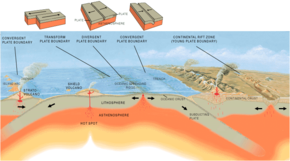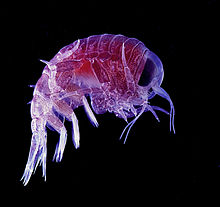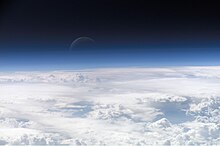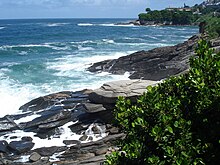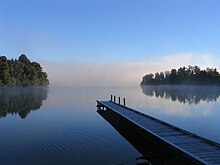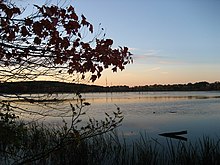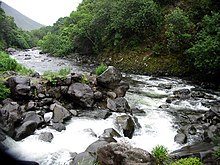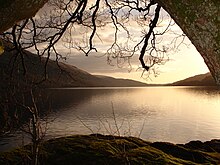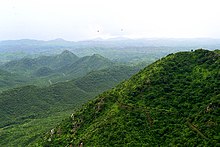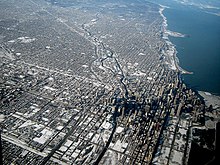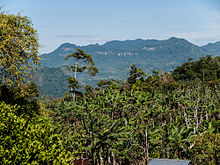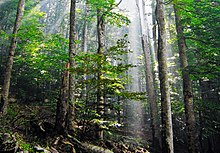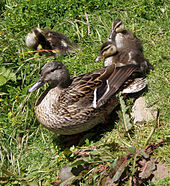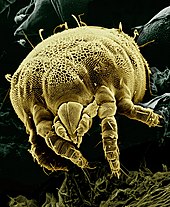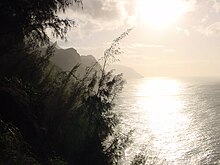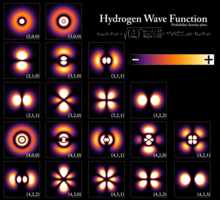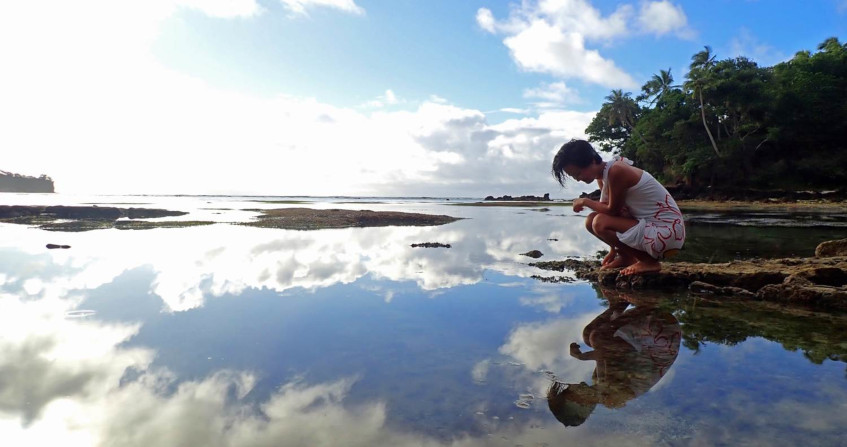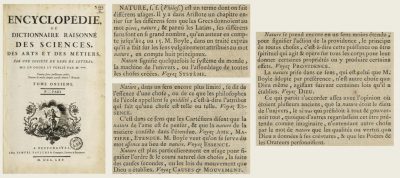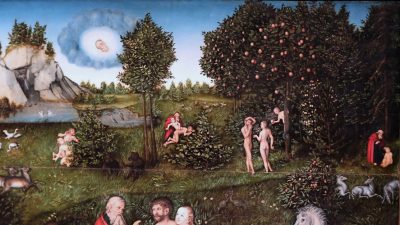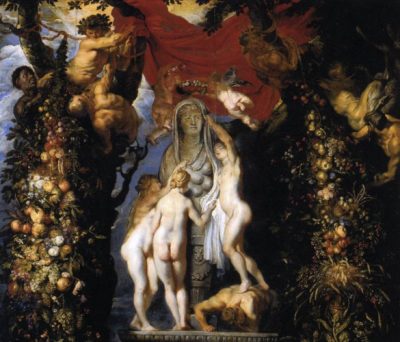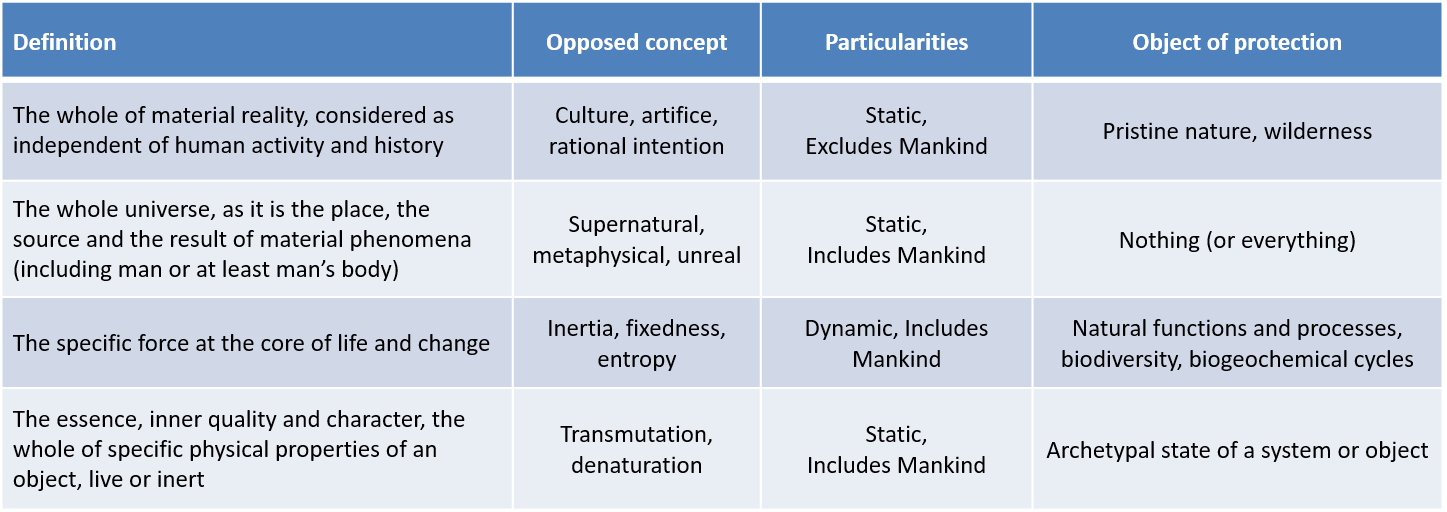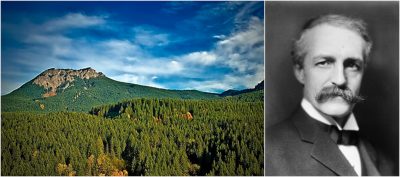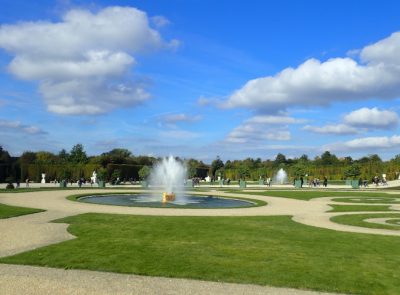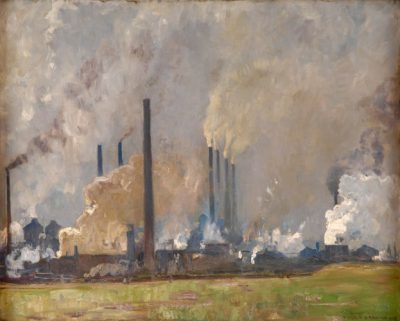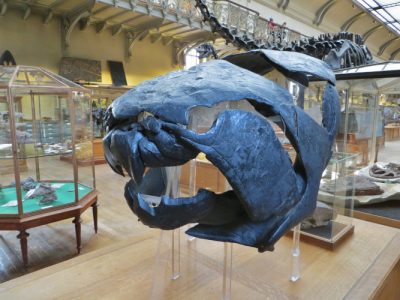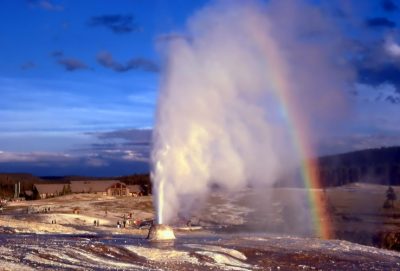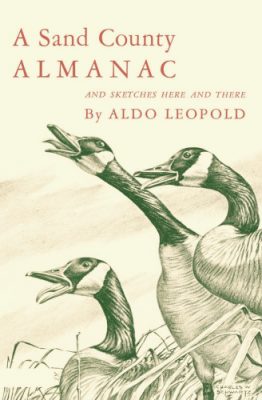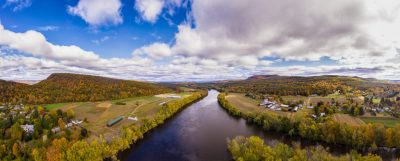Nature, in the broadest sense, is the physical world or universe. «Nature» can refer to the phenomena of the physical world, and also to life in general. The study of nature is a large, if not the only, part of science. Although humans are part of nature, human activity is often understood as a separate category from other natural phenomena.[1]
The word nature is borrowed from the Old French nature and is derived from the Latin word natura, or «essential qualities, innate disposition», and in ancient times, literally meant «birth».[2] In ancient philosophy, natura is mostly used as the Latin translation of the Greek word physis (φύσις), which originally related to the intrinsic characteristics of plants, animals, and other features of the world to develop of their own accord.[3][4]
The concept of nature as a whole, the physical universe, is one of several expansions of the original notion;[1] it began with certain core applications of the word φύσις by pre-Socratic philosophers (though this word had a dynamic dimension then, especially for Heraclitus), and has steadily gained currency ever since.
During the advent of modern scientific method in the last several centuries, nature became the passive reality, organized and moved by divine laws.[5][6] With the Industrial revolution, nature increasingly became seen as the part of reality deprived from intentional intervention: it was hence considered as sacred by some traditions (Rousseau, American transcendentalism) or a mere decorum for divine providence or human history (Hegel, Marx). However, a vitalist vision of nature, closer to the pre-Socratic one, got reborn at the same time, especially after Charles Darwin.[1]
Within the various uses of the word today, «nature» often refers to geology and wildlife. Nature can refer to the general realm of living plants and animals, and in some cases to the processes associated with inanimate objects—the way that particular types of things exist and change of their own accord, such as the weather and geology of the Earth. It is often taken to mean the «natural environment» or wilderness—wild animals, rocks, forest, and in general those things that have not been substantially altered by human intervention, or which persist despite human intervention. For example, manufactured objects and human interaction generally are not considered part of nature, unless qualified as, for example, «human nature» or «the whole of nature». This more traditional concept of natural things that can still be found today implies a distinction between the natural and the artificial, with the artificial being understood as that which has been brought into being by a human consciousness or a human mind. Depending on the particular context, the term «natural» might also be distinguished from the unnatural or the supernatural.[1]
Earth
Earth is the only planet known to support life, and its natural features are the subject of many fields of scientific research. Within the Solar System, it is third closest to the Sun; it is the largest terrestrial planet and the fifth largest overall. Its most prominent climatic features are its two large polar regions, two relatively narrow temperate zones, and a wide equatorial tropical to subtropical region.[7] Precipitation varies widely with location, from several metres of water per year to less than a millimetre. 71 percent of the Earth’s surface is covered by salt-water oceans. The remainder consists of continents and islands, with most of the inhabited land in the Northern Hemisphere.
Earth has evolved through geological and biological processes that have left traces of the original conditions. The outer surface is divided into several gradually migrating tectonic plates. The interior remains active, with a thick layer of plastic mantle and an iron-filled core that generates a magnetic field. This iron core is composed of a solid inner phase, and a fluid outer phase. Convective motion in the core generates electric currents through dynamo action, and these, in turn, generate the geomagnetic field.
The atmospheric conditions have been significantly altered from the original conditions by the presence of life-forms,[8] which create an ecological balance that stabilizes the surface conditions. Despite the wide regional variations in climate by latitude and other geographic factors, the long-term average global climate is quite stable during interglacial periods,[9] and variations of a degree or two of average global temperature have historically had major effects on the ecological balance, and on the actual geography of the Earth.[10][11]
Geology
Geology is the science and study of the solid and liquid matter that constitutes the Earth. The field of geology encompasses the study of the composition, structure, physical properties, dynamics, and history of Earth materials, and the processes by which they are formed, moved, and changed. The field is a major academic discipline, and is also important for mineral and hydrocarbon extraction, knowledge about and mitigation of natural hazards, some Geotechnical engineering fields, and understanding past climates and environments.
Geological evolution
The geology of an area evolves through time as rock units are deposited and inserted and deformational processes change their shapes and locations.
Rock units are first emplaced either by deposition onto the surface or intrude into the overlying rock. Deposition can occur when sediments settle onto the surface of the Earth and later lithify into sedimentary rock, or when as volcanic material such as volcanic ash or lava flows, blanket the surface. Igneous intrusions such as batholiths, laccoliths, dikes, and sills, push upwards into the overlying rock, and crystallize as they intrude.
After the initial sequence of rocks has been deposited, the rock units can be deformed and/or metamorphosed. Deformation typically occurs as a result of horizontal shortening, horizontal extension, or side-to-side (strike-slip) motion. These structural regimes broadly relate to convergent boundaries, divergent boundaries, and transform boundaries, respectively, between tectonic plates.
Historical perspective
An animation showing the movement of the continents from the separation of Pangaea until the present day
Earth is estimated to have formed 4.54 billion years ago from the solar nebula, along with the Sun and other planets.[12] The Moon formed roughly 20 million years later. Initially molten, the outer layer of the Earth cooled, resulting in the solid crust. Outgassing and volcanic activity produced the primordial atmosphere. Condensing water vapor, most or all of which came from ice delivered by comets, produced the oceans and other water sources.[13] The highly energetic chemistry is believed to have produced a self-replicating molecule around 4 billion years ago.[14]
Plankton inhabit oceans, seas and lakes, and have existed in various forms for at least 2 billion years[15]
Continents formed, then broke up and reformed as the surface of Earth reshaped over hundreds of millions of years, occasionally combining to make a supercontinent. Roughly 750 million years ago, the earliest known supercontinent Rodinia, began to break apart. The continents later recombined to form Pannotia which broke apart about 540 million years ago, then finally Pangaea, which broke apart about 180 million years ago.[16]
During the Neoproterozoic era, freezing temperatures covered much of the Earth in glaciers and ice sheets. This hypothesis has been termed the «Snowball Earth», and it is of particular interest as it precedes the Cambrian explosion in which multicellular life forms began to proliferate about 530–540 million years ago.[17]
Since the Cambrian explosion there have been five distinctly identifiable mass extinctions.[18] The last mass extinction occurred some 66 million years ago, when a meteorite collision probably triggered the extinction of the non-avian dinosaurs and other large reptiles, but spared small animals such as mammals. Over the past 66 million years, mammalian life diversified.[19]
Several million years ago, a species of small African ape gained the ability to stand upright.[15] The subsequent advent of human life, and the development of agriculture and further civilization allowed humans to affect the Earth more rapidly than any previous life form, affecting both the nature and quantity of other organisms as well as global climate. By comparison, the Great Oxygenation Event, produced by the proliferation of algae during the Siderian period, required about 300 million years to culminate.
The present era is classified as part of a mass extinction event, the Holocene extinction event, the fastest ever to have occurred.[20][21] Some, such as E. O. Wilson of Harvard University, predict that human destruction of the biosphere could cause the extinction of one-half of all species in the next 100 years.[22] The extent of the current extinction event is still being researched, debated and calculated by biologists.[23][24][25]
Atmosphere, climate, and weather
The Earth’s atmosphere is a key factor in sustaining the ecosystem. The thin layer of gases that envelops the Earth is held in place by gravity. Air is mostly nitrogen, oxygen, water vapor, with much smaller amounts of carbon dioxide, argon, etc. The atmospheric pressure declines steadily with altitude. The ozone layer plays an important role in depleting the amount of ultraviolet (UV) radiation that reaches the surface. As DNA is readily damaged by UV light, this serves to protect life at the surface. The atmosphere also retains heat during the night, thereby reducing the daily temperature extremes.
Terrestrial weather occurs almost exclusively in the lower part of the atmosphere, and serves as a convective system for redistributing heat.[26] Ocean currents are another important factor in determining climate, particularly the major underwater thermohaline circulation which distributes heat energy from the equatorial oceans to the polar regions. These currents help to moderate the differences in temperature between winter and summer in the temperate zones. Also, without the redistributions of heat energy by the ocean currents and atmosphere, the tropics would be much hotter, and the polar regions much colder.
Weather can have both beneficial and harmful effects. Extremes in weather, such as tornadoes or hurricanes and cyclones, can expend large amounts of energy along their paths, and produce devastation. Surface vegetation has evolved a dependence on the seasonal variation of the weather, and sudden changes lasting only a few years can have a dramatic effect, both on the vegetation and on the animals which depend on its growth for their food.
Climate is a measure of the long-term trends in the weather. Various factors are known to influence the climate, including ocean currents, surface albedo, greenhouse gases, variations in the solar luminosity, and changes to the Earth’s orbit. Based on historical records, the Earth is known to have undergone drastic climate changes in the past, including ice ages.
The climate of a region depends on a number of factors, especially latitude. A latitudinal band of the surface with similar climatic attributes forms a climate region. There are a number of such regions, ranging from the tropical climate at the equator to the polar climate in the northern and southern extremes. Weather is also influenced by the seasons, which result from the Earth’s axis being tilted relative to its orbital plane. Thus, at any given time during the summer or winter, one part of the Earth is more directly exposed to the rays of the sun. This exposure alternates as the Earth revolves in its orbit. At any given time, regardless of season, the Northern and Southern Hemispheres experience opposite seasons.
Weather is a chaotic system that is readily modified by small changes to the environment, so accurate weather forecasting is limited to only a few days.[27] Overall, two things are happening worldwide: (1) temperature is increasing on the average; and (2) regional climates have been undergoing noticeable changes.[28]
Water on the Earth
Water is a chemical substance that is composed of hydrogen and oxygen (H2O) and is vital for all known forms of life.[29] In typical usage, water refers only to its liquid form or state, but the substance also has a solid state, ice, and a gaseous state, water vapor, or steam. Water covers 71% of the Earth’s surface.[30] On Earth, it is found mostly in oceans and other large bodies of water, with 1.6% of water below ground in aquifers and 0.001% in the air as vapor, clouds, and precipitation.[31][32] Oceans hold 97% of surface water, glaciers, and polar ice caps 2.4%, and other land surface water such as rivers, lakes, and ponds 0.6%. Additionally, a minute amount of the Earth’s water is contained within biological bodies and manufactured products.
Oceans
A view of the Atlantic Ocean from Leblon, Rio de Janeiro
An ocean is a major body of saline water, and a principal component of the hydrosphere. Approximately 71% of the Earth’s surface (an area of some 361 million square kilometers) is covered by ocean, a continuous body of water that is customarily divided into several principal oceans and smaller seas. More than half of this area is over 3,000 meters (9,800 feet) deep. Average oceanic salinity is around 35 parts per thousand (ppt) (3.5%), and nearly all seawater has a salinity in the range of 30 to 38 ppt. Though generally recognized as several ‘separate’ oceans, these waters comprise one global, interconnected body of salt water often referred to as the World Ocean or global ocean.[33][34] This concept of a global ocean as a continuous body of water with relatively free interchange among its parts is of fundamental importance to oceanography.[35]
The major oceanic divisions are defined in part by the continents, various archipelagos, and other criteria: these divisions are (in descending order of size) the Pacific Ocean, the Atlantic Ocean, the Indian Ocean, the Southern Ocean, and the Arctic Ocean. Smaller regions of the oceans are called seas, gulfs, bays and other names. There are also salt lakes, which are smaller bodies of landlocked saltwater that are not interconnected with the World Ocean. Two notable examples of salt lakes are the Aral Sea and the Great Salt Lake.
Lakes
Main article: Lake
A lake (from Latin word lacus) is a terrain feature (or physical feature), a body of liquid on the surface of a world that is localized to the bottom of basin (another type of landform or terrain feature; that is, it is not global) and moves slowly if it moves at all. On Earth, a body of water is considered a lake when it is inland, not part of the ocean, is larger and deeper than a pond, and is fed by a river.[36][37] The only world other than Earth known to harbor lakes is Titan, Saturn’s largest moon, which has lakes of ethane, most likely mixed with methane. It is not known if Titan’s lakes are fed by rivers, though Titan’s surface is carved by numerous river beds. Natural lakes on Earth are generally found in mountainous areas, rift zones, and areas with ongoing or recent glaciation. Other lakes are found in endorheic basins or along the courses of mature rivers. In some parts of the world, there are many lakes because of chaotic drainage patterns left over from the last ice age. All lakes are temporary over geologic time scales, as they will slowly fill in with sediments or spill out of the basin containing them.
Ponds
Main article: Pond
A pond is a body of standing water, either natural or man-made, that is usually smaller than a lake. A wide variety of man-made bodies of water are classified as ponds, including water gardens designed for aesthetic ornamentation, fish ponds designed for commercial fish breeding, and solar ponds designed to store thermal energy. Ponds and lakes are distinguished from streams via current speed. While currents in streams are easily observed, ponds and lakes possess thermally driven micro-currents and moderate wind driven currents. These features distinguish a pond from many other aquatic terrain features, such as stream pools and tide pools.
Rivers
A river is a natural watercourse,[38] usually freshwater, flowing towards an ocean, a lake, a sea or another river. In a few cases, a river simply flows into the ground or dries up completely before reaching another body of water. Small rivers may also be called by several other names, including stream, creek, brook, rivulet, and rill; there is no general rule that defines what can be called a river. Many names for small rivers are specific to geographic location; one example is Burn in Scotland and North-east England. Sometimes a river is said to be larger than a creek, but this is not always the case, due to vagueness in the language.[39] A river is part of the hydrological cycle. Water within a river is generally collected from precipitation through surface runoff, groundwater recharge, springs, and the release of stored water in natural ice and snowpacks (i.e., from glaciers).
Streams
A stream is a flowing body of water with a current, confined within a bed and stream banks. In the United States, a stream is classified as a watercourse less than 60 feet (18 metres) wide. Streams are important as conduits in the water cycle, instruments in groundwater recharge, and they serve as corridors for fish and wildlife migration. The biological habitat in the immediate vicinity of a stream is called a riparian zone. Given the status of the ongoing Holocene extinction, streams play an important corridor role in connecting fragmented habitats and thus in conserving biodiversity. The study of streams and waterways in general involves many branches of inter-disciplinary natural science and engineering, including hydrology, fluvial geomorphology, aquatic ecology, fish biology, riparian ecology, and others.
Ecosystems
Loch Lomond in Scotland forms a relatively isolated ecosystem. The fish community of this lake has remained unchanged over a very long period of time.[40]
Ecosystems are composed of a variety of biotic and abiotic components that function in an interrelated way.[41] The structure and composition is determined by various environmental factors that are interrelated. Variations of these factors will initiate dynamic modifications to the ecosystem. Some of the more important components are soil, atmosphere, radiation from the sun, water, and living organisms.
Central to the ecosystem concept is the idea that living organisms interact with every other element in their local environment. Eugene Odum, a founder of ecology, stated: «Any unit that includes all of the organisms (ie: the «community») in a given area interacting with the physical environment so that a flow of energy leads to clearly defined trophic structure, biotic diversity, and material cycles (i.e.: exchange of materials between living and nonliving parts) within the system is an ecosystem.»[42] Within the ecosystem, species are connected and dependent upon one another in the food chain, and exchange energy and matter between themselves as well as with their environment.[43] The human ecosystem concept is based on the human/nature dichotomy and the idea that all species are ecologically dependent on each other, as well as with the abiotic constituents of their biotope.[44]
A smaller unit of size is called a microecosystem. For example, a microsystem can be a stone and all the life under it. A macroecosystem might involve a whole ecoregion, with its drainage basin.[45]
Wilderness
Wilderness is generally defined as areas that have not been significantly modified by human activity. Wilderness areas can be found in preserves, estates, farms, conservation preserves, ranches, national forests, national parks, and even in urban areas along rivers, gulches, or otherwise undeveloped areas. Wilderness areas and protected parks are considered important for the survival of certain species, ecological studies, conservation, and solitude. Some nature writers believe wilderness areas are vital for the human spirit and creativity,[46] and some ecologists consider wilderness areas to be an integral part of the Earth’s self-sustaining natural ecosystem (the biosphere). They may also preserve historic genetic traits and that they provide habitat for wild flora and fauna that may be difficult or impossible to recreate in zoos, arboretums, or laboratories.
Life
Female mallard and ducklings – reproduction is essential for continuing life
Although there is no universal agreement on the definition of life, scientists generally accept that the biological manifestation of life is characterized by organization, metabolism, growth, adaptation, response to stimuli, and reproduction.[47] Life may also be said to be simply the characteristic state of organisms.
Properties common to terrestrial organisms (plants, animals, fungi, protists, archaea, and bacteria) are that they are cellular, carbon-and-water-based with complex organization, having a metabolism, a capacity to grow, respond to stimuli, and reproduce. An entity with these properties is generally considered life. However, not every definition of life considers all of these properties to be essential. Human-made analogs of life may also be considered to be life.
The biosphere is the part of Earth’s outer shell—including land, surface rocks, water, air and the atmosphere—within which life occurs, and which biotic processes in turn alter or transform. From the broadest geophysiological point of view, the biosphere is the global ecological system integrating all living beings and their relationships, including their interaction with the elements of the lithosphere (rocks), hydrosphere (water), and atmosphere (air). The entire Earth contains over 75 billion tons (150 trillion pounds or about 6.8×1013 kilograms) of biomass (life), which lives within various environments within the biosphere.[48]
Over nine-tenths of the total biomass on Earth is plant life, on which animal life depends very heavily for its existence.[49] More than 2 million species of plant and animal life have been identified to date,[50] and estimates of the actual number of existing species range from several million to well over 50 million.[51][52][53] The number of individual species of life is constantly in some degree of flux, with new species appearing and others ceasing to exist on a continual basis.[54][55] The total number of species is in rapid decline.[56][57][58]
Evolution
The origin of life on Earth is not well understood, but it is known to have occurred at least 3.5 billion years ago,[61][62][63] during the hadean or archean eons on a primordial Earth that had a substantially different environment than is found at present.[64] These life forms possessed the basic traits of self-replication and inheritable traits. Once life had appeared, the process of evolution by natural selection resulted in the development of ever-more diverse life forms.
Species that were unable to adapt to the changing environment and competition from other life forms became extinct. However, the fossil record retains evidence of many of these older species. Current fossil and DNA evidence shows that all existing species can trace a continual ancestry back to the first primitive life forms.[64]
When basic forms of plant life developed the process of photosynthesis the sun’s energy could be harvested to create conditions which allowed for more complex life forms.[65] The resultant oxygen accumulated in the atmosphere and gave rise to the ozone layer. The incorporation of smaller cells within larger ones resulted in the development of yet more complex cells called eukaryotes.[66] Cells within colonies became increasingly specialized, resulting in true multicellular organisms. With the ozone layer absorbing harmful ultraviolet radiation, life colonized the surface of Earth.
Microbes
The first form of life to develop on the Earth were microbes, and they remained the only form of life until about a billion years ago when multi-cellular organisms began to appear.[67] Microorganisms are single-celled organisms that are generally microscopic, and smaller than the human eye can see. They include Bacteria, Fungi, Archaea, and Protista.
These life forms are found in almost every location on the Earth where there is liquid water, including in the Earth’s interior.[68]
Their reproduction is both rapid and profuse. The combination of a high mutation rate and a horizontal gene transfer[69] ability makes them highly adaptable, and able to survive in new environments, including outer space.[70] They form an essential part of the planetary ecosystem. However, some microorganisms are pathogenic and can post health risk to other organisms.
Plants and animals
Originally Aristotle divided all living things between plants, which generally do not move fast enough for humans to notice, and animals. In Linnaeus’ system, these became the kingdoms Vegetabilia (later Plantae) and Animalia. Since then, it has become clear that the Plantae as originally defined included several unrelated groups, and the fungi and several groups of algae were removed to new kingdoms. However, these are still often considered plants in many contexts. Bacterial life is sometimes included in flora,[71][72] and some classifications use the term bacterial flora separately from plant flora.
Among the many ways of classifying plants are by regional floras, which, depending on the purpose of study, can also include fossil flora, remnants
of plant life from a previous era. People in many regions and countries take great pride in their individual arrays of characteristic flora, which can vary widely across the globe due to differences in climate and terrain.
Regional floras commonly are divided into categories such as native flora and agricultural and garden flora, the lastly mentioned of which are intentionally grown and cultivated. Some types of «native flora» actually have been introduced centuries ago by people migrating from one region or continent to another, and become an integral part of the native, or natural flora of the place to which they were introduced. This is an example of how human interaction with nature can blur the boundary of what is considered nature.
Another category of plant has historically been carved out for weeds. Though the term has fallen into disfavor among botanists as a formal way to categorize «useless» plants, the informal use of the word «weeds» to describe those plants that are deemed worthy of elimination is illustrative of the general tendency of people and societies to seek to alter or shape the course of nature. Similarly, animals are often categorized in ways such as domestic, farm animals, wild animals, pests, etc. according to their relationship to human life.
Animals as a category have several characteristics that generally set them apart from other living things. Animals are eukaryotic and usually multicellular (although see Myxozoa), which separates them from bacteria, archaea, and most protists. They are heterotrophic, generally digesting food in an internal chamber, which separates them from plants and algae. They are also distinguished from plants, algae, and fungi by lacking cell walls.
With a few exceptions—most notably the two phyla consisting of sponges and placozoans—animals have bodies that are differentiated into tissues. These include muscles, which are able to contract and control locomotion, and a nervous system, which sends and processes signals. There is also typically an internal digestive chamber. The eukaryotic cells possessed by all animals are surrounded by a characteristic extracellular matrix composed of collagen and elastic glycoproteins. This may be calcified to form structures like shells, bones, and spicules, a framework upon which cells can move about and be reorganized during development and maturation, and which supports the complex anatomy required for mobility.
Human interrelationship
Human impact
Although humans comprise only a minuscule proportion of the total living biomass on Earth, the human effect on nature is disproportionately large. Because of the extent of human influence, the boundaries between what humans regard as nature and «made environments» is not clear cut except at the extremes. Even at the extremes, the amount of natural environment that is free of discernible human influence is diminishing at an increasingly rapid pace. A 2020 study published in Nature found that anthropogenic mass (human-made materials) outweighs all living biomass on earth, with plastic alone exceeding the mass of all land and marine animals combined.[73] And according to a 2021 study published in Frontiers in Forests and Global Change, only about 3% of the planet’s terrestrial surface is ecologically and faunally intact, with a low human footprint and healthy populations of native animal species.[74][75]
The development of technology by the human race has allowed the greater exploitation of natural resources and has helped to alleviate some of the risk from natural hazards. In spite of this progress, however, the fate of human civilization remains closely linked to changes in the environment. There exists a highly complex feedback loop between the use of advanced technology and changes to the environment that are only slowly becoming understood.[76] Man-made threats to the Earth’s natural environment include pollution, deforestation, and disasters such as oil spills. Humans have contributed to the extinction of many plants and animals,[77] with roughly 1 million species threatened with extinction within decades.[78] The loss of biodiversity and ecosystem functions over the last half century have impacted the extent that nature can contribute to human quality of life,[79] and continued declines could pose a major threat to the continued existence of human civilization, unless a rapid course correction is made.[80] The value of natural resources to human society is not reflected in market prices because mostly natural resources are available free of charge. This distorts market pricing of natural resources and at the same time leads to underinvestment in our natural assets. The annual global cost of public subsidies that damage nature is conservatively estimated at $4–$6 trillion (million million). Institutional protections of these natural goods, such as the oceans and rainforests, are lacking. Governments have not prevented these economic externalities.[81][82]
Humans employ nature for both leisure and economic activities. The acquisition of natural resources for industrial use remains a sizable component of the world’s economic system.[83][84] Some activities, such as hunting and fishing, are used for both sustenance and leisure, often by different people. Agriculture was first adopted around the 9th millennium BCE. Ranging from food production to energy, nature influences economic wealth.
Although early humans gathered uncultivated plant materials for food and employed the medicinal properties of vegetation for healing,[85] most modern human use of plants is through agriculture. The clearance of large tracts of land for crop growth has led to a significant reduction in the amount available of forestation and wetlands, resulting in the loss of habitat for many plant and animal species as well as increased erosion.[86]
Aesthetics and beauty
Aesthetically pleasing flowers
Beauty in nature has historically been a prevalent theme in art and books, filling large sections of libraries and bookstores. That nature has been depicted and celebrated by so much art, photography, poetry, and other literature shows the strength with which many people associate nature and beauty. Reasons why this association exists, and what the association consists of, are studied by the branch of philosophy called aesthetics. Beyond certain basic characteristics that many philosophers agree about to explain what is seen as beautiful, the opinions are virtually endless.[87] Nature and wildness have been important subjects in various eras of world history. An early tradition of landscape art began in China during the Tang Dynasty (618–907). The tradition of representing nature as it is became one of the aims of Chinese painting and was a significant influence in Asian art.
Although natural wonders are celebrated in the Psalms and the Book of Job, wilderness portrayals in art became more prevalent in the 1800s, especially in the works of the Romantic movement. British artists John Constable and J. M. W. Turner turned their attention to capturing the beauty of the natural world in their paintings. Before that, paintings had been primarily of religious scenes or of human beings. William Wordsworth’s poetry described the wonder of the natural world, which had formerly been viewed as a threatening place. Increasingly the valuing of nature became an aspect of Western culture.[88] This artistic movement also coincided with the Transcendentalist movement in the Western world. A common classical idea of beautiful art involves the word mimesis, the imitation of nature. Also in the realm of ideas about beauty in nature is that the perfect is implied through perfect mathematical forms and more generally by patterns in nature. As David Rothenburg writes, «The beautiful is the root of science and the goal of art, the highest possibility that humanity can ever hope to see».[89]: 281
Matter and energy
Some fields of science see nature as matter in motion, obeying certain laws of nature which science seeks to understand. For this reason the most fundamental science is generally understood to be «physics»—the name for which is still recognizable as meaning that it is the «study of nature«.
Matter is commonly defined as the substance of which physical objects are composed. It constitutes the observable universe. The visible components of the universe are now believed to compose only 4.9 percent of the total mass. The remainder is believed to consist of 26.8 percent cold dark matter and 68.3 percent dark energy.[90] The exact arrangement of these components is still unknown and is under intensive investigation by physicists.
The behaviour of matter and energy throughout the observable universe appears to follow well-defined physical laws. These laws have been employed to produce cosmological models that successfully explain the structure and the evolution of the universe we can observe. The mathematical expressions of the laws of physics employ a set of twenty physical constants[91] that appear to be static across the observable universe.[92] The values of these constants have been carefully measured, but the reason for their specific values remains a mystery.
Beyond Earth
Outer space, also simply called space, refers to the relatively empty regions of the Universe outside the atmospheres of celestial bodies. Outer space is used to distinguish it from airspace (and terrestrial locations). There is no discrete boundary between Earth’s atmosphere and space, as the atmosphere gradually attenuates with increasing altitude. Outer space within the Solar System is called interplanetary space, which passes over into interstellar space at what is known as the heliopause.
Outer space is sparsely filled with several dozen types of organic molecules discovered to date by microwave spectroscopy, blackbody radiation left over from the Big Bang and the origin of the universe, and cosmic rays, which include ionized atomic nuclei and various subatomic particles. There is also some gas, plasma and dust, and small meteors. Additionally, there are signs of human life in outer space today, such as material left over from previous crewed and uncrewed launches which are a potential hazard to spacecraft. Some of this debris re-enters the atmosphere periodically.
Although Earth is the only body within the Solar System known to support life, evidence suggests that in the distant past the planet Mars possessed bodies of liquid water on the surface.[93] For a brief period in Mars’ history, it may have also been capable of forming life. At present though, most of the water remaining on Mars is frozen.
If life exists at all on Mars, it is most likely to be located underground where liquid water can still exist.[94]
Conditions on the other terrestrial planets, Mercury and Venus, appear to be too harsh to support life as we know it. But it has been conjectured that Europa, the fourth-largest moon of Jupiter, may possess a sub-surface ocean of liquid water and could potentially host life.[95]
Astronomers have started to discover extrasolar Earth analogs – planets that lie in the habitable zone of space surrounding a star, and therefore could possibly host life as we know it.[96]
See also
- Force of nature
- Human nature
- Natural history
- Naturalism
- Natural landscape
- Natural law
- Natural resource
- Natural science
- Natural theology
- Nature reserve
- Nature versus nurture
- Nature worship
- Naturism
- Rewilding
Media:
- National Wildlife, a publication of the National Wildlife Federation
- Natural History, by Pliny the Elder
- Natural World (TV series)
- Nature, by Ralph Waldo Emerson
- Nature, a prominent scientific journal
- Nature (TV series)
- The World We Live In (Life magazine)
Organizations:
- Nature Detectives
- The Nature Conservancy
Philosophy:
- Balance of nature (biological fallacy), a discredited concept of natural equilibrium in predator–prey dynamics
- Mother Nature
- Naturalism, any of several philosophical stances, typically those descended from materialism and pragmatism that do not distinguish the supernatural from nature;[97] this includes the methodological naturalism of natural science, which makes the methodological assumption that observable events in nature are explained only by natural causes, without assuming either the existence or non-existence of the supernatural
- Nature (philosophy)
Notes and references
- ^ a b c d Ducarme, Frédéric; Couvet, Denis (2020). «What does ‘nature’ mean?». Palgrave Communications. Springer Nature. 6 (14). doi:10.1057/s41599-020-0390-y.
- ^ Harper, Douglas. «nature». Online Etymology Dictionary. Retrieved September 23, 2006.
- ^ An account of the pre-Socratic use of the concept of φύσις may be found in Naddaf, Gerard (2006) The Greek Concept of Nature, SUNY Press, and in Ducarme, Frédéric; Couvet, Denis (2020). «What does ‘nature’ mean?». Palgrave Communications. Springer Nature. 6 (14). doi:10.1057/s41599-020-0390-y.. The word φύσις, while first used in connection with a plant in Homer, occurs early in Greek philosophy, and in several senses. Generally, these senses match rather well the current senses in which the English word nature is used, as confirmed by Guthrie, W.K.C. Presocratic Tradition from Parmenides to Democritus (volume 2 of his History of Greek Philosophy), Cambridge UP, 1965.
- ^ The first known use of physis was by Homer in reference to the intrinsic qualities of a plant: ὣς ἄρα φωνήσας πόρε φάρμακον ἀργεϊφόντης ἐκ γαίης ἐρύσας, καί μοι φύσιν αὐτοῦ ἔδειξε. (So saying, Argeiphontes [=Hermes] gave me the herb, drawing it from the ground, and showed me its nature.) Odyssey 10.302–03 (ed. A.T. Murray). (The word is dealt with thoroughly in Liddell and Scott’s Greek Lexicon Archived March 5, 2011, at the Wayback Machine.) For later but still very early Greek uses of the term, see earlier note.
- ^ Isaac Newton’s Philosophiae Naturalis Principia Mathematica (1687), for example, is translated «Mathematical Principles of Natural Philosophy», and reflects the then-current use of the words «natural philosophy», akin to «systematic study of nature»
- ^ The etymology of the word «physical» shows its use as a synonym for «natural» in about the mid-15th century: Harper, Douglas. «physical». Online Etymology Dictionary. Retrieved September 20, 2006.
- ^
«World Climates». Blue Planet Biomes. Archived from the original on December 17, 2008. Retrieved September 21, 2006. - ^ «Calculations favor reducing atmosphere for early Earth». Science Daily. September 11, 2005. Archived from the original on August 30, 2006. Retrieved January 6, 2007.
- ^ «Past Climate Change». U.S. Environmental Protection Agency. Archived from the original on May 11, 2012. Retrieved January 7, 2007.
- ^ Hugh Anderson; Bernard Walter (March 28, 1997). «History of Climate Change». NASA. Archived from the original on January 23, 2008. Retrieved January 7, 2007.
- ^ Weart, Spencer (June 2006). «The Discovery of Global Warming». American Institute of Physics. Archived from the original on August 4, 2011. Retrieved January 7, 2007.
- ^ Dalrymple, G. Brent (1991). The Age of the Earth. Stanford: Stanford University Press. ISBN 978-0-8047-1569-0.
- ^
Morbidelli, A.; et al. (2000). «Source Regions and Time Scales for the Delivery of Water to Earth». Meteoritics & Planetary Science. 35 (6): 1309–20. Bibcode:2000M&PS…35.1309M. doi:10.1111/j.1945-5100.2000.tb01518.x. - ^
«Earth’s Oldest Mineral Grains Suggest an Early Start for Life». NASA Astrobiology Institute. December 24, 2001. Archived from the original on September 28, 2006. Retrieved May 24, 2006. - ^ a b Margulis, Lynn; Dorian Sagan (1995). What is Life?. New York: Simon & Schuster. ISBN 978-0-684-81326-4.
- ^ Murphy, J.B.; R.D. Nance (2004). «How do supercontinents assemble?». American Scientist. 92 (4): 324. doi:10.1511/2004.4.324. Archived from the original on January 28, 2011. Retrieved August 23, 2010.
- ^ Kirschvink, J.L. (1992). «Late Proterozoic Low-Latitude Global Glaciation: The Snowball Earth» (PDF). In J.W. Schopf; C. Klein (eds.). The Proterozoic Biosphere. Cambridge: Cambridge University Press. pp. 51–52. ISBN 978-0-521-36615-1.
- ^ Raup, David M.; J. John Sepkoski Jr. (March 1982). «Mass extinctions in the marine fossil record». Science. 215 (4539): 1501–03. Bibcode:1982Sci…215.1501R. doi:10.1126/science.215.4539.1501. PMID 17788674. S2CID 43002817.
- ^ Margulis, Lynn; Dorian Sagan (1995). What is Life?. New York: Simon & Schuster. p. 145. ISBN 978-0-684-81326-4.
- ^ Diamond J; Ashmole, N. P.; Purves, P. E. (1989). «The present, past and future of human-caused extinctions». Philos Trans R Soc Lond B Biol Sci. 325 (1228): 469–76, discussion 476–77. Bibcode:1989RSPTB.325..469D. doi:10.1098/rstb.1989.0100. PMID 2574887.
- ^ Novacek M; Cleland E (2001). «The current biodiversity extinction event: scenarios for mitigation and recovery». Proc Natl Acad Sci USA. 98 (10): 5466–70. Bibcode:2001PNAS…98.5466N. doi:10.1073/pnas.091093698. PMC 33235. PMID 11344295.
- ^ Wick, Lucia; Möhl, Adrian (2006). «The mid-Holocene extinction of silver fir (Abies alba) in the Southern Alps: a consequence of forest fires? Palaeobotanical records and forest simulations» (PDF). Vegetation History and Archaeobotany. 15 (4): 435–44. doi:10.1007/s00334-006-0051-0. S2CID 52953180. Archived (PDF) from the original on November 15, 2018. Retrieved November 15, 2018.
- ^ The Holocene Extinction Archived September 25, 2006, at the Wayback Machine. Park.org. Retrieved on November 3, 2016.
- ^ Mass Extinctions Of The Phanerozoic Menu Archived September 25, 2006, at the Wayback Machine. Park.org. Retrieved on November 3, 2016.
- ^ Patterns of Extinction Archived September 25, 2006, at the Wayback Machine. Park.org. Retrieved on November 3, 2016.
- ^ Miller; Spoolman, Scott (September 28, 2007). Environmental Science: Problems, Connections and Solutions. Cengage Learning. ISBN 978-0-495-38337-6.
- ^ Stern, Harvey; Davidson, Noel (May 25, 2015). «Trends in the skill of weather prediction at lead times of 1–14 days». Quarterly Journal of the Royal Meteorological Society. 141 (692): 2726–36. Bibcode:2015QJRMS.141.2726S. doi:10.1002/qj.2559. S2CID 119942734.
- ^ «Tropical Ocean Warming Drives Recent Northern Hemisphere Climate Change». Science Daily. April 6, 2001. Archived from the original on April 21, 2006. Retrieved May 24, 2006.
- ^ «Water for Life». Un.org. March 22, 2005. Archived from the original on May 14, 2011. Retrieved May 14, 2011.
- ^ «World». CIA – World Fact Book. Retrieved December 20, 2008.
- ^ Water Vapor in the Climate System, Special Report, American Geophysical Union, December 1995.
- ^ Vital Water. UNEP.
- ^ «Ocean Archived January 26, 2011, at the Wayback Machine». The Columbia Encyclopedia. 2002. New York: Columbia University Press
- ^ «Distribution of land and water on the planet Archived May 31, 2008, at the Wayback Machine». UN Atlas of the Oceans Archived September 15, 2008, at the Wayback Machine
- ^ Spilhaus, Athelstan F (1942). «Maps of the whole world ocean». Geographical Review. 32 (3): 431–35. doi:10.2307/210385. JSTOR 210385.
- ^
Britannica Online. «Lake (physical feature)». Archived from the original on June 11, 2008. Retrieved June 25, 2008.[a Lake is] any relatively large body of slowly moving or standing water that occupies an inland basin of appreciable size. Definitions that precisely distinguish lakes, ponds, swamps, and even rivers and other bodies of nonoceanic water are not well established. It may be said, however, that rivers and streams are relatively fast moving; marshes and swamps contain relatively large quantities of grasses, trees, or shrubs; and ponds are relatively small in comparison to lakes. Geologically defined, lakes are temporary bodies of water.
- ^ «Lake Definition». Dictionary.com. Archived from the original on September 5, 2016. Retrieved September 6, 2016.
- ^ River {definition} Archived February 21, 2010, at the Wayback Machine from Merriam-Webster. Accessed February 2010.
- ^ USGS – U.S. Geological Survey – FAQs Archived July 1, 2015, at the Wayback Machine, No. 17 What is the difference between mountain, hill, and peak; lake and pond; or river and creek?
- ^ Adams, C.E. (1994). «The fish community of Loch Lomond, Scotland: its history and rapidly changing status». Hydrobiologia. 290 (1–3): 91–102. doi:10.1007/BF00008956. S2CID 6894397. Archived from the original on January 14, 2012. Retrieved January 5, 2007.
- ^ Pidwirny, Michael (2006). «Introduction to the Biosphere: Introduction to the Ecosystem Concept». Fundamentals of Physical Geography (2nd Edition). Archived from the original on July 18, 2011. Retrieved September 28, 2006.
- ^ Odum, EP (1971) Fundamentals of ecology, 3rd edition, Saunders New York
- ^ Pidwirny, Michael (2006). «Introduction to the Biosphere: Organization of Life». Fundamentals of Physical Geography (2nd edition). Archived from the original on August 13, 2011. Retrieved September 28, 2006.
- ^ Khan, Firdos Alam (2011). Biotechnology Fundamentals. CRC Press. ISBN 978-1-4398-2009-4.
- ^ Bailey, Robert G. (April 2004). «Identifying Ecoregion Boundaries» (PDF). Environmental Management. 34 (Supplement 1): S14–26. doi:10.1007/s00267-003-0163-6. PMID 15883869. S2CID 31998098. Archived from the original (PDF) on October 1, 2009.
- ^ Botkin, Daniel B. (2000) No Man’s Garden, Island Press, pp. 155–57, ISBN 1-55963-465-0.
- ^ «Definition of Life». California Academy of Sciences. 2006. Archived from the original on February 8, 2007. Retrieved January 7, 2007.
- ^ The figure «about one-half of one percent» takes into account the following (See, e.g., Leckie, Stephen (1999). «How Meat-centred Eating Patterns Affect Food Security and the Environment». For hunger-proof cities: sustainable urban food systems. Ottawa: International Development Research Centre. ISBN 978-0-88936-882-8. Archived from the original on November 13, 2010., which takes global average weight as 60 kg.), the total human biomass is the average weight multiplied by the current human population of approximately 6.5 billion (see, e.g., «World Population Information». U.S. Census Bureau. Retrieved September 28, 2006.[permanent dead link]): Assuming 60–70 kg to be the average human mass (approximately 130–150 lb on the average), an approximation of total global human mass of between 390 billion (390×109) and 455 billion kg (between 845 billion and 975 billion lb, or about 423 million–488 million short tons). The total biomass of all kinds on earth is estimated to be in excess of 6.8 x 1013 kg (75 billion short tons). By these calculations, the portion of total biomass accounted for by humans would be very roughly 0.6%.
- ^ Sengbusch, Peter V. «The Flow of Energy in Ecosystems – Productivity, Food Chain, and Trophic Level». Botany online. University of Hamburg Department of Biology. Archived from the original on July 26, 2011. Retrieved September 23, 2006.
- ^ Pidwirny, Michael (2006). «Introduction to the Biosphere: Species Diversity and Biodiversity». Fundamentals of Physical Geography (2nd Edition). Archived from the original on July 18, 2011. Retrieved September 23, 2006.
- ^ «How Many Species are There?». Extinction Web Page Class Notes. Archived from the original on September 9, 2006. Retrieved September 23, 2006.
- ^ «Animal.» World Book Encyclopedia. 16 vols. Chicago: World Book, 2003. This source gives an estimate of from 2 to 50 million.
- ^ «Just How Many Species Are There, Anyway?». Science Daily. May 2003. Archived from the original on February 11, 2007. Retrieved September 26, 2006.
- ^ Withers, Mark A.; et al. (1998). «Changing Patterns in the Number of Species in North American Floras». Land Use History of North America. Archived from the original on September 23, 2006. Retrieved September 26, 2006. Website based on the contents of the book: Sisk, T.D., ed. (1998). Perspectives on the land use history of North America: a context for understanding our changing environment (Revised September 1999 ed.). U.S. Geological Survey, Biological Resources Division. USGS/BRD/BSR-1998-0003.
- ^ «Tropical Scientists Find Fewer Species Than Expected». Science Daily. April 2002. Archived from the original on August 30, 2006. Retrieved September 27, 2006.
- ^ Bunker, Daniel E.; et al. (November 2005). «Species Loss and Aboveground Carbon Storage in a Tropical Forest». Science. 310 (5750): 1029–31. Bibcode:2005Sci…310.1029B. CiteSeerX 10.1.1.465.7559. doi:10.1126/science.1117682. PMID 16239439. S2CID 42696030.
- ^ Wilcox, Bruce A. (2006). «Amphibian Decline: More Support for Biocomplexity as a Research Paradigm». EcoHealth. 3 (1): 1–2. doi:10.1007/s10393-005-0013-5. S2CID 23011961.
- ^ Clarke, Robin; Robert Lamb; Dilys Roe Ward, eds. (2002). «Decline and loss of species». Global environment outlook 3: past, present and future perspectives. London; Sterling, VA: Nairobi, Kenya: UNEP. ISBN 978-92-807-2087-7.
- ^ «Why the Amazon Rainforest is So Rich in Species: News». Earthobservatory.nasa.gov. December 5, 2005. Archived from the original on February 25, 2011. Retrieved May 14, 2011.
- ^ «Why The Amazon Rainforest Is So Rich in Species». Sciencedaily.com. December 5, 2005. Archived from the original on February 25, 2011. Retrieved May 14, 2011.
- ^ Schopf, J. William; Kudryavtsev, Anatoliy B.; Czaja, Andrew D.; Tripathi, Abhishek B. (2007). «Evidence of Archean life: Stromatolites and microfossils». Precambrian Research. 158 (3–4): 141–155. Bibcode:2007PreR..158..141S. doi:10.1016/j.precamres.2007.04.009.
- ^ Schopf, JW (2006). «Fossil evidence of Archaean life». Philos Trans R Soc Lond B Biol Sci. 361 (1470): 869–85. doi:10.1098/rstb.2006.1834. PMC 1578735. PMID 16754604.
- ^ Raven, Peter Hamilton; Johnson, George Brooks (2002). Biology. McGraw-Hill Education. p. 68. ISBN 978-0-07-112261-0. Retrieved July 7, 2013.
- ^ a b Line, M. (January 1, 2002). «The enigma of the origin of life and its timing». Microbiology. 148 (Pt 1): 21–27. doi:10.1099/00221287-148-1-21. PMID 11782495.
- ^ «Photosynthesis more ancient than thought, and most living things could do it». Phys.org. Archived from the original on January 20, 2019. Retrieved January 19, 2019.
- ^ Berkner, L. V.; L. C. Marshall (May 1965). «On the Origin and Rise of Oxygen Concentration in the Earth’s Atmosphere». Journal of the Atmospheric Sciences. 22 (3): 225–61. Bibcode:1965JAtS…22..225B. doi:10.1175/1520-0469(1965)022<0225:OTOARO>2.0.CO;2.
- ^ Schopf J (1994). «Disparate rates, differing fates: tempo and mode of evolution changed from the Precambrian to the Phanerozoic». Proc Natl Acad Sci USA. 91 (15): 6735–42. Bibcode:1994PNAS…91.6735S. doi:10.1073/pnas.91.15.6735. PMC 44277. PMID 8041691.
- ^ Szewzyk U; Szewzyk R; Stenström T (1994). «Thermophilic, anaerobic bacteria isolated from a deep borehole in granite in Sweden». Proc Natl Acad Sci USA. 91 (5): 1810–13. Bibcode:1994PNAS…91.1810S. doi:10.1073/pnas.91.5.1810. PMC 43253. PMID 11607462.
- ^ Wolska K (2003). «Horizontal DNA transfer between bacteria in the environment». Acta Microbiol Pol. 52 (3): 233–43. PMID 14743976.
- ^ Horneck G (1981). «Survival of microorganisms in space: a review». Adv Space Res. 1 (14): 39–48. doi:10.1016/0273-1177(81)90241-6. PMID 11541716.
- ^ «flora». Merriam-Webster Online Dictionary. Merriam-Webster. Archived from the original on April 30, 2006. Retrieved September 27, 2006.
- ^ «Glossary». Status and Trends of the Nation’s Biological Resources. Reston, VA: Department of the Interior, Geological Survey. 1998. SuDocs No. I 19.202:ST 1/V.1-2. Archived from the original on July 15, 2007.
- ^ Elhacham, Emily; Ben-Uri, Liad; et al. (2020). «Global human-made mass exceeds all living biomass». Nature. 588 (7838): 442–444. Bibcode:2020Natur.588..442E. doi:10.1038/s41586-020-3010-5. PMID 33299177. S2CID 228077506.
- ^ Carrington, Damian (April 15, 2021). «Just 3% of world’s ecosystems remain intact, study suggests». The Guardian. Retrieved April 16, 2021.
- ^ Plumptre, Andrew J.; Baisero, Daniele; et al. (2021). «Where Might We Find Ecologically Intact Communities?». Frontiers in Forests and Global Change. 4. doi:10.3389/ffgc.2021.626635.
- ^ «Feedback Loops in Global Climate Change Point to a Very Hot 21st Century». Science Daily. May 22, 2006. Archived from the original on December 8, 2006. Retrieved January 7, 2007.
- ^ Kolbert, Elizabeth (2014). The Sixth Extinction: An Unnatural History. New York City: Henry Holt and Company. ISBN 978-0805092998.
- ^ Stokstad, Erik (May 5, 2019). «Landmark analysis documents the alarming global decline of nature». Science. doi:10.1126/science.aax9287. S2CID 166478506.
- ^ Brauman, Kate A.; Garibaldi, Lucas A. (2020). «Global trends in nature’s contributions to people». PNAS. 117 (51): 32799–32805. Bibcode:2020PNAS..11732799B. doi:10.1073/pnas.2010473117. PMC 7768808. PMID 33288690.
- ^ Bradshaw, Corey J. A.; Ehrlich, Paul R.; Beattie, Andrew; Ceballos, Gerardo; Crist, Eileen; Diamond, Joan; Dirzo, Rodolfo; Ehrlich, Anne H.; Harte, John; Harte, Mary Ellen; Pyke, Graham; Raven, Peter H.; Ripple, William J.; Saltré, Frédérik; Turnbull, Christine; Wackernagel, Mathis; Blumstein, Daniel T. (2021). «Underestimating the Challenges of Avoiding a Ghastly Future». Frontiers in Conservation Science. 1. doi:10.3389/fcosc.2020.615419.
- ^ UK Government Official Documents, February 2021, «The Economics of Biodiversity: The Dasgupta Review Headline Messages» p. 2
- ^ Carrington, Damian (February 2, 2021). «Economics of biodiversity review: what are the recommendations?». The Guardian. Retrieved November 13, 2021.
- ^ «Natural Resources contribution to GDP». World Development Indicators (WDI). November 2014. Archived from the original on December 23, 2014.
- ^ «GDP – Composition by Sector». The World Factbook. Central Intelligence Agency. Archived from the original on May 22, 2014. Retrieved February 19, 2017.
- ^ «Plant Conservation Alliance – Medicinal Plant Working Groups Green Medicine». US National Park Services. Archived from the original on October 9, 2006. Retrieved September 23, 2006.
- ^ Oosthoek, Jan (1999). «Environmental History: Between Science & Philosophy». Environmental History Resources. Archived from the original on June 26, 2007. Retrieved December 1, 2006.
- ^ «On the Beauty of Nature». The Wilderness Society. Archived from the original on September 9, 2006. Retrieved September 29, 2006.
- ^ History of Conservation Archived July 8, 2006, at the Wayback Machine BC Spaces for Nature. Accessed: May 20, 2006.
- ^ Rothenberg, David (2011). Survival of the Beautiful: Art, Science and Evolution. Bloomsbury. ISBN 978-1-60819-216-8.
- ^ Ade, P. A. R.; Aghanim, N.; Armitage-Caplan, C.; et al. (Planck Collaboration) (March 22, 2013). «Planck 2013 results. I. Overview of products and scientific results – Table 9». Astronomy and Astrophysics. 571: A1. arXiv:1303.5062. Bibcode:2014A&A…571A…1P. doi:10.1051/0004-6361/201321529. S2CID 218716838.
- ^ Taylor, Barry N. (1971). «Introduction to the constants for nonexperts». National Institute of Standards and Technology. Archived from the original on January 7, 2007. Retrieved January 7, 2007.
- ^ Varshalovich, D.A.; Potekhin, A.Y. & Ivanchik, A.V. (2000). «Testing cosmological variability of fundamental constants». AIP Conference Proceedings. 506: 503. arXiv:physics/0004062. Bibcode:2000AIPC..506..503V. CiteSeerX 10.1.1.43.6877. doi:10.1063/1.1302777.
- ^ Bibring, J; et al. (2006). «Global mineralogical and aqueous mars history derived from OMEGA/Mars Express data». Science. 312 (5772): 400–04. Bibcode:2006Sci…312..400B. doi:10.1126/science.1122659. PMID 16627738.
- ^ Malik, Tariq (March 8, 2005). «Hunt for Mars life should go underground». Space.com via NBC News. Retrieved September 4, 2006.
- ^ Turner, Scott (March 2, 1998). «Detailed Images From Europa Point To Slush Below Surface». NASA. Archived from the original on September 29, 2006. Retrieved September 28, 2006.
- ^ Choi, Charles Q. (March 21, 2011) New Estimate for Alien Earths: 2 Billion in Our Galaxy Alone | Alien Planets, Extraterrestrial Life & Extrasolar Planets | Exoplanets & Kepler Space Telescope Archived July 3, 2013, at the Wayback Machine. Space.com.
- ^ Papineau, David (2016) «Naturalism», The Stanford Encyclopedia of Philosophy, Edward N. Zalta (ed.), Archived April 1, 2019, at the Wayback Machine>
Further reading
- Droz, Layna; et al. (May 31, 2022). «Exploring the diversity of conceptualizations of nature in East and South-East Asia». Humanities and Social Sciences Communications. 9 (1): 1–12. doi:10.1057/s41599-022-01186-5. ISSN 2662-9992.
- Ducarme, Frédéric; Couvet, Denis (2020). «What does ‘nature’ mean?». Palgrave Communications. Springer Nature. 6 (14). doi:10.1057/s41599-020-0390-y.
- Emerson, Ralph W. (1836). Nature. Boston: James Munroe & Co.
- Farber, Paul Lawrence (2000), Finding Order in Nature: The Naturalist Tradition from Linnaeus to E. O. Wilson. Johns Hopkins University Press: Baltimore.
- Naddaf, Gerard (2006). The Greek Concept of Nature. Albany: SUNY Press.
- Piccolo, John J.; Taylor, Bron; Washington, Haydn; Kopnina, Helen; Gray, Joe; Alberro, Heather; Orlikowska, Ewa (2022). ««Nature’s contributions to people» and peoples’ moral obligations to nature». Biological Conservation. 270: 109572. doi:10.1016/j.biocon.2022.109572. S2CID 248769087.
- Worster, D. (1994). Nature’s Economy: A History of Ecological Ideas. Cambridge: Cambridge University Press.
External links
- The IUCN Red List of Threatened Species (iucnredlist.org)
- Ducarme, Frédéric (January 3, 2021). «What is nature?». Encyclopedia of the Environment.
English[edit]
Alternative forms[edit]
- natuer (obsolete)
Etymology[edit]
From Middle English nature, natur, from Old French nature, from Latin nātūra (“birth, origin, natural constitution or quality”), future participle from perfect passive participle (g)natus (“born”), from deponent verb (g)nasci (“to be born, originate”) + future participle suffix -urus. Displaced native Old English ġecynd. More at kind.
Pronunciation[edit]
- (Received Pronunciation) enPR: nā’-chə(r) IPA(key): /ˈneɪ.tʃə/
- (General American) IPA(key): /ˈneɪ.t͡ʃɚ/
- (Northern England) IPA(key): /ˈnɛː.tʃɐ/
- (General Australian) IPA(key): /ˈnæɪ̯.tʃə/
- (New Zealand) IPA(key): /ˈnæe.tʃə/, [ˈnæetʃə], [ˈnɐetʃə]
- Rhymes: -eɪtʃə(ɹ)
- Hyphenation: na‧ture
Noun[edit]
nature (countable and uncountable, plural natures)
- (uncountable, often capitalized) The way things are, the totality of all things in the physical universe and their order, especially the physical world in contrast to spiritual realms and flora and fauna as distinct from human conventions, art, and technology.
-
1667, John Milton, “Book VIII”, in Paradise Lost. […], London: […] [Samuel Simmons], […], →OCLC; republished as Paradise Lost in Ten Books: […], London: Basil Montagu Pickering […], 1873, →OCLC:
-
I oft admire
How Nature, wise and frugal, could commit
Such disproportions.
-
- 1808, Dugald Stewart, Elements of the Philosophy of the Human Mind, pp. 315–6:
- In the works of nature we find, in many instances, beauty and sublimity involved among circumstances, which are either indifferent, or which obstruct the general effect: and it is only by a train of experiments, that we can separate those circumstances from the rest… Accordingly, the inexperienced artist, when he copies nature, will copy her servilely… and the beauties of his performances will be encumbered with a number of superfluous or disagreeable concomitants. Experience and observation alone can enable him to make this determination: to exhibit the principles of beauty pure and unadulterated, and to form a creation of his own, more faultless, than ever fell under the observation of his senses.
- 1816, Matthew Harris Jouett, Notes… on Painting with Gilbert Stuart Esqr:
- Most persons in striving after effect lose the likeness when they should go together to produce a good effect you must copy Nature: leave Nature for an imaginary effect & you lose all. Nature as Nature cannot be exceeded, and as your object it [is] to copy Nature twere the hight of folly to look at any thing else to produce that copy.
-
1850, Nathaniel Hawthorne, The Scarlet Letter, a Romance, Boston, Mass.: Ticknor, Reed, and Fields, →OCLC, [https://archive.org/details/scarletletterrom01hawt/page/186/mode/2up 186–7/mode/1up page 186–7]:
-
Nothing was more common, in those days, than to interpret all meteoric appearances, and other natural phenomena, that occurred with less regularity than the rise and set of sun and moon, as so many revelations from a supernatural source… But what shall we say, when an individual discovers a revelation, addressed to himself alone, on the same vast sheet of record! In such a case, it could only be the symptom of a highly disordered mental state, when a man, rendered morbidly self-contemplative by long, intense, and secret pain, had extended his egotism over the whole expanse of nature, until the firmament itself should appear no more than a fitting page for his soul’s history and fate.
-
- 1891, Oscar Wilde, The Decay of Lying
- Nature has good intentions, of course, but, as Aristotle once said, she cannot carry them out. When I look at a landscape I cannot help seeing all its defects.
- 1895, Thomas Hardy, Jude the Obscure, p. 15:
- Nature’s logic was too horrid for him to care for.
- 1918, Constance Garnett translating Fyodor Dostoevsky as «Notes from Underground» in White Nights and Other Stories, pp. 58–9:
- …they will shout at you, it is no use protesting: it is a case of twice two makes four! Nature does not ask your permission, she has nothing to do with your wishes, and whether you like her laws or dislike them, you are bound to accept her as she is, and consequently all her conclusions. A wall, you see, is a wall… Merciful Heavens! but what do I care for the laws of nature and arithmetic, when, for some reason I dislike those laws and the fact that twice two makes four? Of course I cannot break through the wall by battering my head against it if I really have not the strength to knock it down, but I am not going to be reconciled to it simply because it is a stone wall and I have not the strength.
- 1928, Christopher Dawson, The Age of the Gods, p. 49:
- Man was entirely at the mercy of nature—a mere scavenger who eked out a miserable existence as a food-gatherer and an eater of shell-fish.
- 2006 Oct. 1, Dennis Lehane, «Refugees», The Wire, 00:34:06:
- Freamon: She too young for you, boy… They get younger, William. Skinnier too. You don’t… ‘s just the nature of things. Age is age, fat is fat, nature’s nature.
Moreland: Pitiful.
Freamon: Pitiless. Nature don’t care. Nature just is.
- Freamon: She too young for you, boy… They get younger, William. Skinnier too. You don’t… ‘s just the nature of things. Age is age, fat is fat, nature’s nature.
-
2012 January 1, Robert M. Pringle, “How to Be Manipulative”, in American Scientist, volume 100, number 1, page 31:
-
As in much of biology, the most satisfying truths in ecology derive from manipulative experimentation. Tinker with nature and quantify how it responds.
-
- 2015, Alisa Luxenberg, «Printing Plants: The Technology of Nature Printing in Eighteenth-Century Spain» in Art, Technology, and Nature, p. 140:
- Gómez Ortega… explicitly ordered them to study only fresh plants, in situ, to draw every part, and ‘to copy nature exactly without presuming to correct it or decorate it as some draughtsmen are used to doing, adding colours and ornaments drawn from their imagination’.
- 2017 Sept. 8, Michael Grunwald, «A Requiem for Florida» in Politico Magazine:
- As Hurricane Irma prepares to strike, it’s worth remembering that Mother Nature never intended us to live here.
- 2021, Olof G. Lidin, From Taoism to Einstein, p. 196:
- The tao of Lao Tzu was a cosmic tao, inner and unwritten, a tao of Nature, while the tao of Confucius was moral and written.
-
Nature doesn’t lie.
-
Tectonic activity is part of nature, so there’s no way to stop earthquakes.
-
- The particular way someone or something is, especially
- The essential or innate characteristics of a person or thing which will always tend to manifest, especially in contrast to specific contexts, reason, religious duty, upbringing, and personal pretense or effort.
-
c. 1606 (date written), William Shakespeare, “The Tragedie of Macbeth”, in Mr. William Shakespeares Comedies, Histories, & Tragedies […] (First Folio), London: […] Isaac Iaggard, and Ed[ward] Blount, published 1623, →OCLC, [Act TROILUS AND CRESSIDA, scene iii], page iii:
-
Vliss.: … One touch of nature makes the whole world kin,
That all with one consent praise new-borne gaudes,
Though they are made and moulded of things past,
And goe to dust, that is a little guilt,
More laud then guilt ore-dusted.
-
-
c. 1606 (date written), William Shakespeare, “The Tragedie of Macbeth”, in Mr. William Shakespeares Comedies, Histories, & Tragedies […] (First Folio), London: […] Isaac Iaggard, and Ed[ward] Blount, published 1623, →OCLC, [Act I, scene v]:
-
Lady. …Glamys thou art, and Cawdor, and shalt be
What thou art promis’d: yet doe I feare thy Nature,
It is too full o’th’ Milke of humane kindnesse,
To catch the neerest way.
-
- 1641, David Fergusson, Scottish proverbs, D4:
- Nature passes norture.
- 1709, Robert Steele, Tatler, No. 93:
- Men may change their Climate, but they cannot their Nature.
- 1834, Criminal Law Commission, «First Report… on Criminal Law», p. 21:
- Domestic animals of a base nature and not fit for food, are not the subjects of theft. This rule includes dogs and cats.
- 1848, Edward Bulwer-Lytton, Harold, Vol. III, p. 375:
- His own better nature which… was magnanimous and heroic, moved and won him.
- 1874, John Henry Blunt, Dictionary of Sects…, p. 332:
- The Monophysites held that the two Natures were so united, that although the ‘One Christ’ was partly Human and partly Divine, His two Natures became by their union only one Nature.
- 1869, Horatio Alger Jr., Mark the Match Boy, Ch. 16:
- Mark hardly knew whether to believe this or not. He already began to suspect that Roswell was something of a humbug, and though it was not in his nature to form a causeless dislike, he certainly did not feel disposed to like Roswell.
- 1874, Francis Galton, English Men of Science, p. 12:
- The phrase ‘nature and nurture’ is a convenient jingle of words, for it separates under two distinct heads the innumerable elements of which personality is composed.
- 1920, Herman Cyril McNeile, Bulldog Drummond, Ch. 1:
- Being by nature of a cheerful disposition, the symptom did not surprise his servant, late private of the same famous regiment, who was laying breakfast in an adjoining room.
- 1926, Richard Henry Tawney, Religion and the Rise of Capitalism, p. 20:
- The contrast between nature and grace, between human appetites and interests and religion, is not absolute, but relative.
- 1961, Barry Crump, Hang on a Minute Mate, p. 147:
- Couples bitching at each other is human nature.
- 2006 Oct. 1, Dennis Lehane, «Refugees», The Wire, 00:34:06:
- Freamon: She too young for you, boy… They get younger, William. Skinnier too. You don’t… ‘s just the nature of things. Age is age, fat is fat, nature’s nature.
Moreland: Pitiful.
Freamon: Pitiless. Nature don’t care. Nature just is.
- Freamon: She too young for you, boy… They get younger, William. Skinnier too. You don’t… ‘s just the nature of things. Age is age, fat is fat, nature’s nature.
- 2015 July 10, Evan Nesterak, «The End of Nature versus Nurture» in The Psych Report:
- Unlike the static conception of nature or nurture, epigenic research demonstrates how genes and environments continuously interact to produce characteristics throughout a lifetime.
-
It’s not in my nature to steal.
-
You can’t help feeling that way. It’s human nature.
-
- The distinguishing characteristic of a person or thing, understood as its general class, sort, type, etc.
- 1626 July 12, Charles I, Instructions:
- For the French, it was impossible for them to serve her in that nature.
-
- A dispute of this nature caused mischief.
-
1910, Emerson Hough, chapter II, in The Purchase Price: Or The Cause of Compromise, Indianapolis, Ind.: The Bobbs-Merrill Company, →OCLC:
-
Carried somehow, somewhither, for some reason, on these surging floods, were these travelers, of errand not wholly obvious to their fellows, yet of such sort as to call into query alike the nature of their errand and their own relations.
-
- 1949, George Orwell, Nineteen Eighty-Four, p. 56:
- And yet, though you could not actually hear what the man was saying, you could not be in any doubt about its general nature.
- 1988 April, Music and Letters, Vol. 69, p. 463:
- The extent and nature of Bach’s influence on Haydn is now due for further reassessment.
-
What was the nature of your relationship with the deceased?
-
The best medium might be petroleum, liquified gas, or something of that nature.
- 1626 July 12, Charles I, Instructions:
- (UK military, obsolete) Synonym of caliber: the class of a gun.
- 1828, James Morton Spearman, The British Gunner, p. 130:
- …One Hundred of each Nature of Case-Shot…
- 1879, War Office, Manual of Siege and Garrison Artillery Exercises, p. 37:
- B.L. cartridges have lubricators choked inside the cartridges of 40-pr. and lower natures.
- 1828, James Morton Spearman, The British Gunner, p. 130:
- The essential or innate characteristics of a person or thing which will always tend to manifest, especially in contrast to specific contexts, reason, religious duty, upbringing, and personal pretense or effort.
- The vital functions or strength of someone or something, especially (now dialect) as requiring nourishment or careful maintenance or (medicine) as a force of regeneration without special treatment.
- 1592, William West, Symbolaeography, Pt. I, §102b:
- Any such corrasiue, sharpe or eager medicine… as the said H. shal think his nature is vnable to suffer…
-
c. 1599–1602 (date written), William Shakespeare, The Tragicall Historie of Hamlet, Prince of Denmarke: […] (Second Quarto), London: […] I[ames] R[oberts] for N[icholas] L[ing] […], published 1604, →OCLC, [Act I, scene iii]:
-
For nature creſſant does not grovve alone / In thevvs and bulkes, but as this temple vvaxes, / The invvard ſervice of the minde and ſoule / Grovves vvide vvithal, […]
- For a human being’s vital functions, increasing, do not grow alone / In physical development and bulk, but as this «temple» [i.e., the body] waxes, / The inward operation of the mind and soul / Grows wide with them.
-
- 1807, Zebulon Pike, An Account of Expeditions to the Source of the Mississippi…, Vol. II, p. 182:
- I returned hungry… and had only snow to supply the calls of nature.
- 1820, Thomas Tredgold, Elementary Principles of Carpentry, p. 165:
- The timber… is found to be brittle and effete; or, to use the workman’s expression, ‘its nature is gone’.
- 1826 April 1, Lancet, p. 32:
- Nature is unable to repair the extensive injury.
- 1843, George Henry Borrow, The Bible in Spain, Vol. III, p. 47:
- The prison allowance will not support nature.
- 1895, T. Pinnock, Tom Brown’s Black Country Annual…:
- My iron’s just comin’ to natur’.
- 1984, William N. Herbert, Sterts & Stobies, p. 30:
- Hungry-groond, ground credited to be so much enchanted that a person passing over it would faint if they did not use something to support nature.
- 1592, William West, Symbolaeography, Pt. I, §102b:
- A requirement or powerful impulse of the body’s physical form, especially
- The need to urinate and defecate.
- 1701, William Wotton, The History of Rome, p. 328:
- He withdrew from the Company to ease Nature.
- 1965, Wole Soyinka, Road, p. 26:
- The women tell you to stop because they’s feeling the call of nature. If you don’t stop they pee in your lorry.
- 1701, William Wotton, The History of Rome, p. 328:
- (now chiefly African-American Vernacular) Sexual desire.
- 1823, Lord Byron, Don Juan, Draft, Canto XV, St. xlix & lii:
- She marvelled «What he saw in such a baby
«As that prim, silent, cold Aurora Raby?»
…Why Adeline had this slight prejudice
…For me appears a question far too nice,
Since Adeline was liberal by Nature;
But Nature’s Nature, and has more caprices
Than I have time, or will to take to pieces…
- She marvelled «What he saw in such a baby
- 1941, William Alexander Percy, Lanterns on the Levee, p. 305:
- He had placed a spell on her by means of a cunjer bag… Its effect was to rob her of connubial allure—in her words, ‘it stole her nature’.
- 1974 July 25, Daily Telegraph, p. 3:
- Every time I felt nature for her, she would rub something on her hands and face to take away my nature.
- 2006 Oct. 1, Dennis Lehane, «Refugees», The Wire, 00:34:06:
- Freamon: She too young for you, boy… They get younger, William. Skinnier too. You don’t… ‘s just the nature of things. Age is age, fat is fat, nature’s nature.
Moreland: Pitiful.
Freamon: Pitiless. Nature don’t care. Nature just is.
- Freamon: She too young for you, boy… They get younger, William. Skinnier too. You don’t… ‘s just the nature of things. Age is age, fat is fat, nature’s nature.
- 1823, Lord Byron, Don Juan, Draft, Canto XV, St. xlix & lii:
- (now chiefly UK regional and African-American Vernacular) Spontaneous love, affection, or reverence, especially between parent and child.
-
c. 1606 (date written), William Shakespeare, “The Tragedie of Macbeth”, in Mr. William Shakespeares Comedies, Histories, & Tragedies […] (First Folio), London: […] Isaac Iaggard, and Ed[ward] Blount, published 1623, →OCLC, [Act I, scene v]:
-
Lady. … Come you Spirits,
That tend on mortall thoughts, vnsex me here,
…make thick my blood,
Stop vp th’accesse, and passage to Remorse,
That no compunctious visitings of Nature
Shake my fell purpose…
-
- 1712, Alexander Pope, «The First Book of Statius’s Thebais» in Miscellaneous Poems and Translations, p. 25:
- Have we not seen (the blood of Laius shed)
The murd’ring son ascend his parent’s bed,
Thro’ violated Nature force his way,
And stain the sacred womb where once he lay?
- Have we not seen (the blood of Laius shed)
- 1749, John Cleland, Memoirs of a Woman of Pleasure, Vol. I, p. 136:
- She had no nature, nor indeed any passion but that of money.
- 1937, Robinson Jeffers, «Thurso’s Landing» in Selected Poetry, p. 312:
- …I could bear much. I’d not move nor scream
While you wrote the red stripes:
But there’s no nature in you…
- …I could bear much. I’d not move nor scream
-
- The need to urinate and defecate.
- (now rare) A product of the body’s physical form, especially semen and vaginal fluids, menstrual fluid, and (obsolete) feces.
- a. 1390, Geoffrey Chaucer, Parson’s Tale, Canterbury Tales:
- …vnkyndely synne by which man or womman shedeth hire nature in manere or in place ther as a child may nat be conceyued…
- c. 1938, spell cited in Harry Middleton Hyatt, Hoodoo Conjuration Witchcraft Rootwork, Vol. I, p. 534:
- If a man want to break his wife from some man, he steals this dishcloth… an’ he ketches her nachure in this dishcloth…
- a. 1390, Geoffrey Chaucer, Parson’s Tale, Canterbury Tales:
- (now rare) A part of the body’s physical form, especially (obsolete) the female genitalia.
- 1743 May, William Ellis, Modern Husbandman, No. xiv, p. 137:
- … offer her the Horse, and… wash her Nature with cold Water …
- 1743 May, William Ellis, Modern Husbandman, No. xiv, p. 137:
Usage notes[edit]
In its primary sense as the material world, its inhabitants, and their order, nature is frequently personified in English conversation and literature, primarily as a cold and indifferent entity or as a wise and loving nurturer (see Mother Nature). In its sense as the essential characteristics of humanity, man’s present nature is usually taken in Christian thought as debased by original sin or inherent frailty but amenable to purification through grace; English consideration of human nature frequently continues to maintain a similar focus on resigned acceptance of its failings and distinctions between better/higher and worse/lower natures.
Synonyms[edit]
- (innate characteristics): See Thesaurus:essence
Derived terms[edit]
Terms derived from nature
[edit]
Terms etymologically related to nature
Translations[edit]
the natural world and its order
- Abkhaz: аԥсабара (apsabara)
- Adyghe: природ (priirood)
- Afrikaans: natuur (af)
- Albanian:mjedis (sq), natyrë (sq) f
- Amharic: ተፈጥሮ (täfäṭro)
- Arabic: طَبِيعَة f (ṭabīʕa)
- Egyptian Arabic: طبيعة f (ṭabīʿa)
- Aragonese: natura f
- Armenian: բնություն (hy) (bnutʿyun)
- Aromanian: fise f
- Assamese: প্ৰকৃতি (prokriti)
- Azerbaijani: təbiət (az)
- Bashkir: тәбиғәт (täbiğät)
- Belarusian: прыро́да (be) f (pryróda)
- Bengali: প্রকৃতি (bn) (prokriti)
- Bulgarian: приро́да (bg) f (priróda)
- Burmese: သဘာဝ (my) (sa.bhawa.), စရိုက် (my) (ca.ruik)
- Buryat: байгаали (bajgaali)
- Catalan: natura (ca) f
- Chinese:
- Cantonese: 自然 (zi6 jin4)
- Dungan: зыжан (zɨřan), зохуа (zohua)
- Mandarin: 自然 (zh) (zìrán), 造化 (zh)
- Min Nan: 自然 (zh-min-nan) (chū-liân / chīr-liân / chū-jiân / chī-liân)
- Wu: 自然 (zr zoe)
- Chuvash: ҫутҫанталӑк (śutśant̬alăk)
- Crimean Tatar: tabiat
- Czech: příroda (cs) f
- Danish: natur (da) c
- Dutch: natuur (nl) f
- Eastern Mari: пӱртӱс (pürtüs)
- Esperanto: naturo
- Estonian: loodus (et)
- Finnish: luonto (fi), ympäristö (fi)
- French: nature (fr) f
- Galician: natureza (gl) f, naturanza f, natura (gl) f
- Georgian: ბუნება (buneba), გარემო (garemo)
- German: Natur (de) f
- Gothic: 𐍅𐌹𐍃𐍄𐍃 f (wists)
- Greek: φύση (el) f (fýsi)
- Ancient: φύσις f (phúsis)
- Gujarati: પ્રકૃતિ (prakṛti), કુદરત (kudrat)
- Haitian Creole: nati
- Hebrew: טֶבַע (he) m (téva)
- Hindi: प्रकृति (hi) f (prakŕti), फ़ितरत (hi) f (fitrat), तबीयत (hi) f (tabīyat), क़ुदरत f (qudrat), कुदरत (hi) f (kudrat), फितरत (hi) f (phitrat), निसर्ग (hi) m (nisarg)
- Hungarian: természet (hu)
- Icelandic: náttúra (is) f, umhverfi (is) n
- Ido: naturo (io)
- Indonesian: alam (id), kodrat (id)
- Irish: nádúr, an dúlra, dúlra
- Italian: natura (it) f
- Japanese: 自然 (ja) (しぜん, shizen)
- Kabardian: природэ (priiroode)
- Kalmyk: йиртмҗ (yirtmj)
- Kannada: ನಿಸರ್ಗ (kn) (nisarga)
- Kazakh: табиғат (kk) (tabiğat)
- Khmer: ធម្មជាតិ (thŏəmmĕəʼciət)
- Korean: 자연(自然) (ko) (jayeon)
- Kurdish:
- Central Kurdish: سروشت (ckb) (sruşt)
- Northern Kurdish: sirişt (ku), xweza (ku), xwerist (ku), tebîet (ku), natûr (ku)
- Kyrgyz: жаратылыш (ky) (jaratılış), табият (ky) (tabiyat)
- Lao: ທຳມະຊາດ (lo) (tham ma sāt)
- Latin: nātūra f
- Latvian: vide f, daba (lv) f
- Lezgi: тӏебиат (ṭebiat)
- Lithuanian: gamta (lt) f
- Low German: natuur (nds) f
- Lü: ᦉᦳᧄᦘᦱᧇ (ṡumphaab)
- Macedonian: природа f (priroda)
- Malay: alam semulajadi, semulajadi, tabiat, alam (ms)
- Malayalam: പ്രകൃതി (ml) (prakr̥ti)
- Maori: ao tūroa, aotūroa
- Marathi: निसर्ग (nisarga)
- Middle Persian: 𐭰𐭩𐭧𐭫 (cyḥl)
- Moksha: перьфпяль (peŕfpæľ)
- Mongolian:
- Cyrillic: байгаль (mn) (bajgalʹ)
- Navajo: tłʼóoʼdi
- Norwegian:
- Bokmål: natur (no) m
- Nynorsk: natur m
- Occitan: natura (oc) f
- Old English: ġecynd f, wist f
- Oriya: ପ୍ରକୃତି (or) (prôkruti)
- Ossetian: ӕрдз (ærʒ)
- Pashto: طبيعت (ps) m (tabi’át)
- Persian: طبیعت (fa) (tabi’at), سرشت (fa) (serešt), نهاد (fa) (nahâd, nehâd), چهر (fa) (čehr)
- Polish: natura (pl) f, przyroda (pl) f
- Portuguese: natureza (pt) f
- Punjabi: ਕੁਦਰਤ (kudrat)
- Quechua: sallqa
- Romanian: natură (ro) f
- Russian: приро́да (ru) f (priróda)
- Rusyn: приро́да f (pryróda)
- Sanskrit: प्रकृति (sa) f (prakṛti)
- Scottish Gaelic: nàdar m
- Serbo-Croatian:
- Cyrillic: при́рода f
- Roman: príroda (sh) f
- Sinhalese: සොබාදහම (sobādahama)
- Slovak: príroda f
- Slovene: narava (sl) f
- Spanish: naturaleza (es) f, natura (es) f (archaic or poetic)
- Swahili: mazingira (sw)
- Swedish: natur (sv) c
- Tagalog: kalikasan
- Tajik: табиат (tg) (tabiat)
- Tamil: இயற்கை (ta) (iyaṟkai)
- Tatar: табигать (tt) (tabigat’)
- Telugu: ప్రకృతి (te) (prakr̥ti)
- Thai: ธรรมชาติ (th) (tam-má-châat)
- Tibetan: རང་བྱུང (rang byung)
- Tigrinya: ተፈጥሮ (täfäṭro)
- Turkish: tabiat (tr), doğa (tr)
- Turkmen: tebigat
- Udmurt: инкуазь (inkuaź)
- Ukrainian: приро́да (uk) f (pryróda)
- Urdu: فِطْرَت f (fitrat), طَبِیعَت f (tabī’at), قُدْرَت f (qudrat)
- Uyghur: تەبىئەت (tebi’et)
- Uzbek: tabiat (uz)
- Vietnamese: ngoài trời (vi), tự nhiên (vi), nguyên thủy (vi), tạo hóa (vi)
- Volapük: nat (vo)
- Yakut: айылҕа (ayılğa)
- Yiddish: נאַטור f (natur), סבֿיבֿה f (svive)
- Zhuang: mbwnnamh
essential characteristics
- Afrikaans: natuur (af)
- Albanian: natyrë (sq) f
- Aragonese: natura f
- Armenian: էություն (hy) (ēutʿyun), բնույթ (hy) (bnuytʿ), բնություն (hy) (bnutʿyun)
- Azerbaijani: səciyyə, xüsusiyyət (az), xarakter
- Belarusian: прыро́да (be) f (pryróda), су́тнасць f (sútnascʹ), су́тнасьць f (sútnasʹcʹ)
- Bulgarian: съ́щност (bg) f (sǎ́štnost), приро́да (bg) f (priróda)
- Burmese: စရိုက် (my) (ca.ruik)
- Catalan: natura (ca) f, natural (ca) m
- Chinese:
- Mandarin: 性質/性质 (zh) (xìngzhì)
- Czech: povaha (cs) f
- Danish: natur (da) c
- Dutch: natuur (nl) f
- Esperanto: naturo
- Estonian: loomus (et), natuur
- Faroese: náttúra f
- Finnish: luonne (fi), luonto (fi)
- French: nature (fr) f
- Galician: natureza (gl) f, natural (gl) m
- Georgian: ბუნება (buneba)
- German: Natur (de) f, Art (de) f
- Gothic: 𐍅𐌹𐍃𐍄𐍃 f (wists)
- Greek: φύση (el) f (fýsi)
- Ancient: φύσις f (phúsis)
- Hebrew: טֶבַע (he) m (téva)
- Hindi: स्वभाव (hi) (svabhāv), फ़ितरत (hi) f (fitrat), फितरत (hi) f (phitrat), ज़ात (hi) f (zāt)
- Hungarian: természet (hu), jelleg (hu)
- Icelandic: náttúra (is) f, eðli n
- Ido: naturo (io)
- Irish: dúchas m
- Italian: natura (it) f
- Japanese: 性質 (ja) (せいしつ, seishitsu)
- Khmer: ធម្មជាតិ (thŏəmmĕəʼciət)
- Korean: 성질(性質) (ko) (seongjil)
- Kurdish:
- Central Kurdish: سروشت (ckb) (sruşt)
- Northern Kurdish: sirişt (ku), xweza (ku), xwerist (ku), tebîet (ku), natûr (ku)
- Latin: natura f, indoles f
- Latvian: daba (lv) f
- Low German: natuur (nds) f
- Macedonian: природа f (priroda), ќуд f (ḱud), нарав m (narav), суштина f (suština)
- Middle Persian: 𐭰𐭩𐭧𐭫 (cyḥl)
- Nogai: табиат (tabiat)
- Norwegian: natur (no) m
- Old English: ġecynd f, wist f
- Old Occitan: natura
- Persian: طبیعت (fa), سرشت (fa) (serešt)
- Polish: natura (pl) f, charakter (pl) m, specyfika (pl) f
- Portuguese: natureza (pt) f
- Romanian: natură (ro) f
- Russian: приро́да (ru) f (priróda), нату́ра (ru) f (natúra), су́щность (ru) f (súščnostʹ)
- Scottish Gaelic: gnè f, nàdar m
- Serbo-Croatian:
- Cyrillic: на́рав f, при́рода f
- Roman: nárav (sh) f, príroda (sh) f
- Slovak: príroda f, povaha f
- Slovene: narava (sl) f
- Spanish: naturaleza (es) f
- Swedish: natur (sv) c
- Tajik: табиат (tg) (tabiat)
- Telugu: స్వభావము (te) (svabhāvamu)
- Ukrainian: приро́да (uk) f (pryróda), су́тність f (sútnistʹ)
- Urdu: فطرت (fitrat)
- Vietnamese: tính (vi), bản chất (vi), bản tính (vi)
- Volapük: please add this translation if you can
- Yiddish: טבֿע f (teyve), נאַטור f (natur)
Translations to be checked
- Bengali: (please verify) প্রকৃতি (bn) (prokriti)
- Estonian: (please verify) loodus (et)
- Hebrew: (please verify) יְקוּם (he) m (yekum)
- Indonesian: (please verify) ilmu (id)
- Korean: (please verify) 나름 (ko) (nareum)
- Lithuanian: (please verify) gamta (lt)
- Ossetian: (please verify) ӕрдз (ærʒ)
- Sundanese: (please verify) élmu (su)
- Thai: (please verify) ศาสตร์ (th) (sàat)
Verb[edit]
nature (third-person singular simple present natures, present participle naturing, simple past and past participle natured)
- (obsolete) To endow with natural qualities.
Further reading[edit]
- “nature, n.”, in OED Online
, Oxford, Oxfordshire: Oxford University Press, 2021.
- nature at OneLook Dictionary Search
- nature in Keywords for Today: A 21st Century Vocabulary, edited by The Keywords Project, Colin MacCabe, Holly Yanacek, 2018.
- «nature» in Raymond Williams, Keywords (revised), 1983, Fontana Press, page 219.
- “nature”, in The Century Dictionary […], New York, N.Y.: The Century Co., 1911, →OCLC.
- nature in Webster’s Revised Unabridged Dictionary, G. & C. Merriam, 1913
Anagrams[edit]
- aunter, natuer, tea urn, tea-urn, unrate
Esperanto[edit]
Pronunciation[edit]
Adverb[edit]
nature
- naturally
French[edit]
Etymology[edit]
Inherited from Middle French nature, Old French nature, borrowed from Latin nātūra.
Pronunciation[edit]
- IPA(key): /na.tyʁ/
Noun[edit]
nature f (plural natures)
- nature
- (grammar) lexical category
Derived terms[edit]
- contre nature
- Dame Nature
- en nature
- état de nature
- force de la nature
- grandeur nature
- nature morte
- petite nature
- plus vrai que nature
- seconde nature
- s’évanouir dans la nature
- tous les goûts sont dans la nature
Adjective[edit]
nature (plural natures)
- plain, unseasoned
-
Une brioche nature ou sucrée ?
- A plain or sweet brioche?
-
File-moi un yaourt nature s’il te plait.
- Give me a plain yogurt, please.
-
- condomless, bareback, raw dog, natural (see Thesaurus:condomless)
-
Une fellation nature.
- A natural blowjob.
-
Further reading[edit]
- “nature”, in Trésor de la langue française informatisé [Digitized Treasury of the French Language], 2012.
Italian[edit]
Noun[edit]
nature f
- plural of natura
Adjective[edit]
nature (invariable)
- natural
Anagrams[edit]
- Arunte, neutra, rutena, untare, unterà
Latin[edit]
Pronunciation[edit]
- (Classical) IPA(key): /naːˈtuː.re/, [näːˈt̪uːrɛ]
- (Ecclesiastical) IPA(key): /naˈtu.re/, [näˈt̪uːre]
Participle[edit]
nātūre
- vocative masculine singular of nātūrus
Middle Dutch[edit]
Etymology[edit]
Borrowed from Old French nature, from Latin nātūra.
Noun[edit]
nature f
- nature, force of nature
- laws of nature, natural order
- nature, innate characteristics
- kind, sort
- origin
- sexual fertility, sex drive
Inflection[edit]
This noun needs an inflection-table template.
Descendants[edit]
- Dutch: natuur
- Limburgish: netuur, netuuer
Further reading[edit]
- “nature”, in Vroegmiddelnederlands Woordenboek, 2000
- Verwijs, E.; Verdam, J. (1885–1929), “nature”, in Middelnederlandsch Woordenboek, The Hague: Martinus Nijhoff, →ISBN
Middle English[edit]
Alternative forms[edit]
- natur, natour, nateure, nater
Etymology[edit]
Borrowed from Old French nature, from Latin nātūra.
Pronunciation[edit]
- IPA(key): /naːˈtiu̯r/
Noun[edit]
nature (plural natures)
- the Universe, existence, creation
- nature, the natural world
- natural abilities
- natural inevitability, nature (as opposed to nurture)
- natural morals, natural law
- natural needs or requirements
- nature, state, condition
- species, kind, type
- Nature (allegory)
[edit]
- natural
Descendants[edit]
- English: nature
- Scots: natur, naitur, naeter, nature
- Yola: naatur
- → Welsh: natur
References[edit]
- “nātūr(e, n.”, in MED Online, Ann Arbor, Mich.: University of Michigan, 2007, retrieved 2018-04-02.
Middle French[edit]
Etymology[edit]
Inherited from Old French nature, borrowed from Latin nātūra.
Noun[edit]
nature f (plural natures)
- nature
Descendants[edit]
- French: nature
Old French[edit]
Etymology[edit]
Learned borrowing from Latin nātūra.
Noun[edit]
nature f (oblique plural natures, nominative singular nature, nominative plural natures)
- nature (natural world; nonhuman world)
-
circa 1170, Chrétien de Troyes, Érec et Énide:
-
De cesti tesmoingne Nature,
Qu’onques si bele creature
Ne fu veüe an tot le monde.- Nature can testify
That never such a beautiful creature
Was seen in the whole world
- Nature can testify
-
-
- nature (character; qualities)
Descendants[edit]
- Middle French: nature
- French: nature
- → Middle Dutch: nature
- Dutch: natuur
- Limburgish: netuur, netuuer
- → Middle English: nature, natur, natour, nateure, nater
- English: nature
- Scots: natur, naitur, naeter, nature
- Yola: naatur
- → Welsh: natur
1
: the external world in its entirety
2
: natural scenery
enjoyed the beauties of nature
3
b
: the inherent character or basic constitution (see constitution sense 2) of a person or thing : essence
the nature of the controversy
4
a
: humankind’s original or natural condition
b
: a simplified mode of life resembling this condition
escape from civilization and get back to nature
5
: a kind or class usually distinguished by fundamental or essential characteristics
documents of a confidential nature
acts of a ceremonial nature
6
: the physical constitution or drives of an organism
especially
: an excretory organ or function
—used in phrases like the call of nature
7
: the genetically controlled qualities of an organism
nature … modified by nurture—
8
a
: a creative and controlling force in the universe
b
: an inner force (such as instinct, appetite, desire) or the sum of such forces in an individual
9
: a spontaneous attitude (as of generosity)
Synonyms
Choose the Right Synonym for nature
type, kind, sort, nature, description, character mean a number of individuals thought of as a group because of a common quality or qualities.
type may suggest strong and clearly marked similarity throughout the items included so that each is typical of the group.
one of three basic body types
kind may suggest natural grouping.
a zoo seemingly having animals of every kind
sort often suggests some disparagement.
the sort of newspaper dealing in sensational stories
nature may imply inherent, essential resemblance rather than obvious or superficial likenesses.
two problems of a similar nature
description implies a group marked by agreement in all details belonging to a type as described or defined.
not all acts of that description are actually illegal
character implies a group marked by distinctive likenesses peculiar to the type.
research on the subject so far has been of an elementary character
Example Sentences
He devoted himself to the study of nature.
That is a color not found in nature.
Hunger is nature’s way of telling you to eat.
Gravity is one of the basic laws of nature.
She’s very competitive by nature.
Recent Examples on the Web
The Cosmic Egg, Holograms, and the Absolute Things start getting really dicey when the report explains the nature of the universe into which the brain sends these signals.
—
Moreno said the posts are inaccurate and misconstrue the nature of the urban planning framework.
—
Also compelling are the questions the novel raises about innovation and ethics, as well as the very nature of being human.
—
The intuitive nature of the heat and use of the burners leaves this grill more consistent in temperature.
—
What was the nature of Fletcher’s interactions with Figueroa?
—
In letters reviewed by Bloomberg that were sent to companies including Circle Internet Financial, BILL Holdings Inc., BlockFi Inc., and Eiger BioPharmaceuticals Inc., Warren and Ocasio-Cortez asked questions about the nature of their connections with SVB.
—
The pervasive nature of plastic contamination in the marine world has come into widespread focus in recent times, with the detection of microplastics (plastic particles smaller than 5 mm) in various marine organisms, including fish, mussels, and crustaceans.
—
Guess that’s the nature of the game.
—
See More
These examples are programmatically compiled from various online sources to illustrate current usage of the word ‘nature.’ Any opinions expressed in the examples do not represent those of Merriam-Webster or its editors. Send us feedback about these examples.
Word History
Etymology
Middle English, from Middle French, from Latin natura, from natus, past participle of nasci to be born — more at nation
First Known Use
14th century, in the meaning defined at sense 3b
Time Traveler
The first known use of nature was
in the 14th century
Dictionary Entries Near nature
Cite this Entry
“Nature.” Merriam-Webster.com Dictionary, Merriam-Webster, https://www.merriam-webster.com/dictionary/nature. Accessed 14 Apr. 2023.
Share
More from Merriam-Webster on nature
Last Updated:
13 Apr 2023
— Updated example sentences
Subscribe to America’s largest dictionary and get thousands more definitions and advanced search—ad free!
Merriam-Webster unabridged
Educalingo cookies are used to personalize ads and get web traffic statistics. We also share information about the use of the site with our social media, advertising and analytics partners.
Download the app
educalingo

We print money. The people that print the money is actually us. The government of the United States of America. By its very nature, we control that, and this system is there as representation of us.
J. C. Chandor
ETYMOLOGY OF THE WORD NATURE
Via Old French from Latin nātūra, from nātus, past participle of nascī to be born.
Etymology is the study of the origin of words and their changes in structure and significance.
PRONUNCIATION OF NATURE
GRAMMATICAL CATEGORY OF NATURE
Nature is a noun.
A noun is a type of word the meaning of which determines reality. Nouns provide the names for all things: people, objects, sensations, feelings, etc.
WHAT DOES NATURE MEAN IN ENGLISH?
Nature
Nature, in the broadest sense, is equivalent to the natural, physical, or material world or universe. «Nature» refers to the phenomena of the physical world, and also to life in general. It ranges in scale from the subatomic to the cosmic. The word nature is derived from the Latin word natura, or «essential qualities, innate disposition», and in ancient times, literally meant «birth». Natura was a Latin translation of the Greek word physis, which originally related to the intrinsic characteristics that plants, animals, and other features of the world develop of their own accord. The concept of nature as a whole, the physical universe, is one of several expansions of the original notion; it began with certain core applications of the word φύσις by pre-Socratic philosophers, and has steadily gained currency ever since. This usage continued during the advent of modern scientific method in the last several centuries. Within the various uses of the word today, «nature» often refers to geology and wildlife.
Definition of nature in the English dictionary
The first definition of nature in the dictionary is the fundamental qualities of a person or thing; identity or essential character. Other definition of nature is the whole system of the existence, arrangement, forces, and events of all physical life that are not controlled by man. Nature is also all natural phenomena and plant and animal life, as distinct from man and his creations.
WORDS THAT RHYME WITH NATURE
Synonyms and antonyms of nature in the English dictionary of synonyms
SYNONYMS OF «NATURE»
The following words have a similar or identical meaning as «nature» and belong to the same grammatical category.
Translation of «nature» into 25 languages

TRANSLATION OF NATURE
Find out the translation of nature to 25 languages with our English multilingual translator.
The translations of nature from English to other languages presented in this section have been obtained through automatic statistical translation; where the essential translation unit is the word «nature» in English.
Translator English — Chinese
自然
1,325 millions of speakers
Translator English — Spanish
naturaleza
570 millions of speakers
English
nature
510 millions of speakers
Translator English — Hindi
प्रकृति
380 millions of speakers
Translator English — Arabic
طَبِيعَةٌ
280 millions of speakers
Translator English — Russian
природа
278 millions of speakers
Translator English — Portuguese
natureza
270 millions of speakers
Translator English — Bengali
প্রকৃতি
260 millions of speakers
Translator English — French
nature
220 millions of speakers
Translator English — Malay
Sifat
190 millions of speakers
Translator English — German
Natur
180 millions of speakers
Translator English — Japanese
自然
130 millions of speakers
Translator English — Korean
자연
85 millions of speakers
Translator English — Javanese
Alam
85 millions of speakers
Translator English — Vietnamese
tự nhiên
80 millions of speakers
Translator English — Tamil
இயற்கை
75 millions of speakers
Translator English — Marathi
निसर्ग
75 millions of speakers
Translator English — Turkish
doğa
70 millions of speakers
Translator English — Italian
natura
65 millions of speakers
Translator English — Polish
natura
50 millions of speakers
Translator English — Ukrainian
природа
40 millions of speakers
Translator English — Romanian
natură
30 millions of speakers
Translator English — Greek
φύση
15 millions of speakers
Translator English — Afrikaans
aard
14 millions of speakers
Translator English — Swedish
natur
10 millions of speakers
Translator English — Norwegian
natur
5 millions of speakers
Trends of use of nature
TENDENCIES OF USE OF THE TERM «NATURE»
The term «nature» is very widely used and occupies the 1.622 position in our list of most widely used terms in the English dictionary.

FREQUENCY
Very widely used
The map shown above gives the frequency of use of the term «nature» in the different countries.
Principal search tendencies and common uses of nature
List of principal searches undertaken by users to access our English online dictionary and most widely used expressions with the word «nature».
FREQUENCY OF USE OF THE TERM «NATURE» OVER TIME
The graph expresses the annual evolution of the frequency of use of the word «nature» during the past 500 years. Its implementation is based on analysing how often the term «nature» appears in digitalised printed sources in English between the year 1500 and the present day.
Examples of use in the English literature, quotes and news about nature
10 QUOTES WITH «NATURE»
Famous quotes and sentences with the word nature.
Man is subject to innumerable pains and sorrows by the very condition of humanity, and yet, as if nature had not sown evils enough in life, we are continually adding grief to grief and aggravating the common calamity by our cruel treatment of one another.
Nature is something outside our body, but the mind is within us.
From a sequence of these individual patterns, whole buildings with the character of nature will form themselves within your thoughts, as easily as sentences.
In nature there are few sharp lines.
I’m a real nature lover, so whenever possible, I like to get to the beach or get to a forest or get somewhere there’s fresh air. Apart from that, I’m a film addict and a DVD freak.
To know what that true self is without social pressure is to know your true nature.
If any of us were faced with a huge bag of free money and very little accountability, it would be human nature that you would make the most of it.
I can find God in nature, in animals, in birds and the environment.
The story of civilization is, in a sense, the story of engineering — that long and arduous struggle to make the forces of nature work for man’s good.
We print money. The people that print the money is actually us. The government of the United States of America. By its very nature, we control that, and this system is there as representation of us.
10 ENGLISH BOOKS RELATING TO «NATURE»
Discover the use of nature in the following bibliographical selection. Books relating to nature and brief extracts from same to provide context of its use in English literature.
1
Handbook of Nature Study
Provides lessons on many topics of nature study, with questions that may form the basis for student projects.
Anna Botsford Comstock, 1939
«Nature is an advanced introduction to its topic. For students, it aims to inform and to challenge by showing that nature is not what it seems to be.
3
The Nature of the Book: Print and Knowledge in the Making
Discusses how books were written, printed, and distributed in early modern England; the relationships among authors, printers, booksellers, and government officials; and the impact of technological innovation.
Describes the education, training, earnings, and outlook associated with twenty careers in nature, including biologists, botanists, ecologists, environmental engineers, geologists, and oceanographers.
Facts On File, Incorporated, 2010
5
The Fractal Geometry of Nature
Three classic fractals, tamed. Galaxies and eddies. Scaling fractals. Nonscaling fractals. Self-mapping fractals. Randomness. Stratified random fractals. Fractional brown fractals. A book-within-the-book, in color. Random tremas; texture.
Benoit B. Mandelbrot, 1983
This is followed by some of Chomsky’s recent writings on these themes, together with a penetrating interview in which Chomsky provides the clearest and most elegant introduction to current theory available.
Noam Chomsky, Adriana Belletti, Luigi Rizzi, 2002
7
Thoreau’s Nature: Ethics, Politics, and the Wild
Thoreau’s Nature: Ethics, Politics, and the Wild explores how Thoreau crafted a life open to ‘the Wild, ‘ a term that marks the startling element of foreignness in every object of experience, however familiar.
8
The Experience of Nature: A Psychological Perspective
In this volume concerning the natural environment, people, and the relationship between them, Rachel and Stephen Kaplan offer the first research-based analysis of the vital psychological role that nature plays in our lives.
Rachel Kaplan, Stephen Kaplan, 1989
9
Nature‘s Services: Societal Dependence On Natural Ecosystems
The book enhances our understanding of the value of the natural systems that surround us and can play an essential role in encouraging greater efforts to protect the earth’s basic life-support systems before it is too late.
10
The Enemy of Nature: The End of Capitalism Or the End of the …
This second, thoroughly updated, edition of The Enemy of Nature speaks to this new environmental awareness. Joel Kovel argues against claims that we can achieve a better environment through the current Western «way of being».
10 NEWS ITEMS WHICH INCLUDE THE TERM «NATURE»
Find out what the national and international press are talking about and how the term nature is used in the context of the following news items.
Researchers quantify nature’s role in human well-being
A structure in the Wolong Nature Reserve in southwestern China suffered heavy damage during the 2008 Wenchuan earthquake. Credit: Wei … «Phys.Org, Jul 15»
DNA–nanoparticle crystals: Exploiting shape complementarity
Writing in Nature Materials, Chad Mirkin and collaborators hypothesized that the interplay of complementarities in nanoparticle size and shape … «Nature.com, Jul 15»
Superconductivity: The FeSe riddle
Writing in Nature Materials, Kosuke Nakayama and colleagues shed some light on this lively debate, by investigating the superconducting … «Nature.com, Jul 15»
Keep nature out with nature
Keep nature out with nature … and bends highlighted in the finished structure — creates a gate just a short step removed from Mother Nature. «The Columbian, Jul 15»
Damon Lane: 1-on-1 interview with Mother Nature
OKLAHOMA CITY —DAMON LANE: Thank you Mother Nature for taking the time to sit down with me. I know you are busy. I have a few … «KOCO Oklahoma City, Jul 15»
Share “Nature to light up during Martin Park’s…”
Naturalists will host a firefly hike from 8 to 10 p.m. Saturday at Martin Park Nature Center, 5000 W Memorial Road in Oklahoma City. The hike … «NewsOK.com, Jul 15»
Dislocation networks: Shedding coherent light on defects
Writing in Nature Materials, Jesse Clark, Johannes Ihli and collaborators demonstrate the ability to non-destructively monitor the whole network … «Nature.com, Jul 15»
“Even Mother Nature Has An Agent”
Nature is a word with multiple meanings. We use nature to designate broadly all-things-that-exist-and-how-they-work-together-and-behave; … «First Things, Jul 15»
Simple cooking methods flush arsenic out of rice
… 2015 · July; Article. Nature | News … burden of their rice.” Journal name: Nature; DOI: doi :10.1038/nature.2015.18034 … From nature.com … «Nature.com, Jul 15»
Square strength
Careful analysis of evolved systems in nature has previously revealed a number of novel design principles that might enhance the performance … «Nature.com, Jul 15»
REFERENCE
« EDUCALINGO. Nature [online]. Available <https://educalingo.com/en/dic-en/nature>. Apr 2023 ».
Download the educalingo app


Discover all that is hidden in the words on
Nature has two inter-related meanings in philosophy and natural philosophy. On the one hand, it means the set of all things which are natural, or subject to the normal working of the laws of nature. On the other hand, it means the essential properties and causes of individual things. How to understand the meaning and significance of nature has been a consistent theme of discussion within the history of Western Civilization, in the philosophical fields of metaphysics and epistemology, as well as in theology and science. The study of natural things and the regular laws which seem to govern them, as opposed to discussion about what it means to be natural, is the area of natural science. The word «nature» derives from Latin nātūra, a philosophical term derived from the verb for birth, which was used as a translation for the earlier (pre-Socratic) Greek term phusis, derived from the verb for natural growth. Already in classical times, philosophical use of these words combined two related meanings which have in common that they refer to the way in which things happen by themselves, «naturally», without «interference» from human deliberation, divine intervention, or anything outside what is considered normal for the natural things being considered. Understandings of nature depend on the subject and age of the work where they appear. For example, Aristotle’s explanation of natural properties differs from what is meant by natural properties in modern philosophical and scientific works, which can also differ from other scientific and conventional usage. Stoicism encourages practitioners to live in accordance with nature. Pyrrhonism encourages practitioners to use the guidance of nature in decision making.
1. Classical Nature and Aristotelian Metaphysics
The Physics (from ta phusika «the natural [things]») is Aristotle’s principal work on nature. In Physics II.1, Aristotle defines a nature as «a source or cause of being moved and of being at rest in that to which it belongs primarily».[1] In other words, a nature is the principle within a natural raw material that is the source of tendencies to change or rest in a particular way unless stopped. For example, a rock would fall unless stopped. Natural things stand in contrast to artifacts, which are formed by human artifice, not because of an innate tendency. (The raw materials of a bed have no tendency to become a bed.) In terms of Aristotle’s theory of four causes, the word natural is applied both to the innate potential of matter cause and the forms which the matter tends to become naturally.[2]
According to Leo Strauss,[3] the beginning of Western philosophy involved the «discovery or invention of nature» and the «pre-philosophical equivalent of nature» was supplied by «such notions as ‘custom’ or ‘ways'». In ancient Greek philosophy on the other hand, Nature or natures are ways that are «really universal» «in all times and places». What makes nature different is that it presupposes not only that not all customs and ways are equal, but also that one can «find one’s bearings in the cosmos» «on the basis of inquiry» (not for example on the basis of traditions or religion). To put this «discovery or invention» into the traditional terminology, what is «by nature» is contrasted to what is «by convention». The concept of nature taken this far remains a strong tradition in modern western thinking. Science, according to Strauss’ commentary of Western history is the contemplation of nature, while technology was or is an attempt to imitate it.[4]
Going further, the philosophical concept of nature or natures as a special type of causation — for example that the way particular humans are is partly caused by something called «human nature» is an essential step towards Aristotle’s teaching concerning causation, which became standard in all Western philosophy until the arrival of modern science.
Depiction of Aristotle. By Visconti — Iconographie Grecque, Public Domain, https://commons.wikimedia.org/w/index.php?curid=2060121
Whether it was intended or not, Aristotle’s inquiries into this subject were long felt to have resolved the discussion about nature in favor of one solution. In this account, there are four different types of cause:
- The material cause is the «raw material» — the matter which undergoes change. One of the causes of a statue being what it is might be that it is bronze. All meanings of the word nature encompass this simple meaning.
- The efficient cause is the motion of another thing, which makes a thing change, for example a chisel hitting a rock causes a chip to break off. This is the way which the matter is forming into a form so that it become substance like what Aristotle said that a substance must have a form and matter in order to call it substance. This is the motion of changing a single being into two. This is the most obvious way in which cause and effect works, as in the descriptions of modern science. But according to Aristotle, this does not yet explain that of which the motion is, and we must «apply ourselves to the question whether there is any other cause per se besides matter».[5]
- The formal cause is the form or idea which serves as a template towards which things develop — for example following an approach based upon Aristotle we could say that a child develops in a way partly determined by a thing called «human nature». Here, nature is a cause.
- The final cause is the aim towards which something is directed. For example, a human aims at something perceived to be good, as Aristotle says in the opening lines of the Nicomachean Ethics.
The formal and final cause are an essential part of Aristotle’s «Metaphysics» — his attempt to go beyond nature and explain nature itself. In practice they imply a human-like consciousness involved in the causation of all things, even things which are not man-made. Nature itself is attributed with having aims.[6]
The artificial, like the conventional therefore, is within this branch of Western thought, traditionally contrasted with the natural. Technology was contrasted with science, as mentioned above. And another essential aspect to this understanding of causation was the distinction between the accidental properties of a thing and the substance — another distinction which has lost favor in the modern era, after having long been widely accepted in medieval Europe.
To describe it another way, Aristotle treated organisms and other natural wholes as existing at a higher level than mere matter in motion. Aristotle’s argument for formal and final causes is related to a doctrine about how it is possible that people know things: «If nothing exists apart from individual things, nothing will be intelligible; everything will be sensible, and there will be no knowledge of anything—unless it be maintained that sense-perception is knowledge».[7] Those philosophers who disagree with this reasoning therefore also see knowledge differently from Aristotle.
Aristotle then, described nature or natures as follows, in a way quite different from modern science:[8]
«Nature» means:
(a) in one sense, the genesis of growing things — as would be suggested by pronouncing the υ of φύσις[9] long—and
(b) in another, that immanent thing from which a growing thing first begins to grow.
(c) The source from which the primary motion in every natural object is induced in that object as such. All things are said to grow which gain increase through something else by contact and organic unity (or adhesion, as in the case of embryos). Organic unity differs from contact; for in the latter case there need be nothing except contact, but in both the things which form an organic unity there is some one and the same thing which produces, instead of mere contact, a unity which is organic, continuous and quantitative (but not qualitative). Again, «nature» means
(d) the primary stuff, shapeless and unchangeable from its own potency, of which any natural object consists or from which it is produced; e.g., bronze is called the «nature» of a statue and of bronze articles, and wood that of wooden ones, and similarly in all other cases. For each article consists of these «natures,» the primary material persisting. It is in this sense that men call the elements of natural objects the «nature,» some calling it fire, others earth or air or water, others something else similar, others some of these, and others all of them. Again in another sense «nature» means
(e) the substance of natural objects; as in the case of those who say that the «nature» is the primary composition of a thing, or as Empedocles says: Of nothing that exists is there nature, but only mixture and separation of what has been mixed; nature is but a name given to these by men. Hence as regards those things which exist or are produced by nature, although that from which they naturally are produced or exist is already present, we say that they have not their nature yet unless they have their form and shape. That which comprises both of these exists by nature; e.g. animals and their parts. And nature is both the primary matter (and this in two senses: either primary in relation to the thing, or primary in general; e.g., in bronze articles the primary matter in relation to those articles is bronze, but in general it is perhaps water—that is if all things which can be melted are water) and the form or essence, i.e. the end of the process, of generation. Indeed from this sense of «nature,» by an extension of meaning, every essence in general is called «nature,» because the nature of anything is a kind of essence. From what has been said, then, the primary and proper sense of «nature» is the essence of those things which contain in themselves as such a source of motion; for the matter is called «nature» because it is capable of receiving the nature, and the processes of generation and growth are called «nature» because they are motions derived from it. And nature in this sense is the source of motion in natural objects, which is somehow inherent in them, either potentially or actually.—Metaphysics 1014b-1015a, translated by Hugh Tredennick, emphasis added.[10]
It has been argued, as will be explained below, that this type of theory represented an oversimplifying diversion from the debates within Classical philosophy, possibly even that Aristotle saw it as a simplification or summary of the debates himself. But in any case the theory of the four causes became a standard part of any advanced education in the Middle Ages.
2. In Eastern Philosophy
2.1. Indian Philosophy
Jain philosophy attempts to explain the rationale of being and existence, the nature of the Universe and its constituents, the nature of bondage and the means to achieve liberation.[11] Jainism strongly upholds the individualistic nature of soul and personal responsibility for one’s decisions; and that self-reliance and individual efforts alone are responsible for one’s liberation.[12]
Ajñana was a Śramaṇa school of radical Indian skepticism and a rival of early Buddhism and Jainism. They held that it was impossible to obtain knowledge of metaphysical nature or ascertain the truth value of philosophical propositions;[13] and even if knowledge was possible, it was useless and disadvantageous for final salvation. They were seen as sophists who specialized in refutation without propagating any positive doctrine of their own. Jayarāśi Bhaṭṭa (fl. c. 800), author of the skeptical work entitled Tattvopaplavasiṃha («The Lion that Devours All Categories»/»The Upsetting of All Principles»), has been seen as an important Ajñana philosopher.[14]
In the Chandogya Upanishad, Aruni asks metaphysical questions concerning the nature of reality and truth, observes constant change, and asks if there is something that is eternal and unchanging. From these questions, embedded in a dialogue with his son, he presents the concept of Ātman (soul, Self) and universal Self.[15][16]
The Ashtavakra Gita, credited to Aṣṭāvakra, examines the metaphysical nature of existence and the meaning of individual freedom, presenting its thesis that there is only one Supreme Reality (Brahman), the entirety of universe is oneness and manifestation of this reality, everything is interconnected, all Self (Atman, soul) are part of that one, and that individual freedom is not the end point but a given, a starting point, innate.[17]
The first book of Yoga Vasistha, attributed to Valmiki, presents Rama’s frustration with the nature of life, human suffering and disdain for the world.[18] The second describes, through the character of Rama, the desire for liberation and the nature of those who seek such liberation.[18] The fourth describes the nature of world and many non-dualism ideas with numerous stories.[18][19] It emphasizes free will and human creative power.[18][20]
Ancient Mīmāṃsā’s central concern was epistemology (pramana), that is what are the reliable means to knowledge. It debated not only «how does man ever learn or know, whatever he knows», but also whether the nature of all knowledge is inherently circular, whether those such as foundationalists who critique the validity of any «justified beliefs» and knowledge system make flawed presumptions of the very premises they critique, and how to correctly interpret and avoid incorrectly interpreting dharma texts such as the Vedas.[21] To Mīmānsā scholars, the nature of non-empirical knowledge and human means to it are such that one can never demonstrate certainty, one can only falsify knowledge claims, in some cases.[21]
Buddhist philosophy’s main concern is soteriological, defined as freedom from dukkha (unease).[22] Because ignorance to the true nature of things is considered one of the roots of suffering, Buddhist thinkers concerned themselves with philosophical questions related to epistemology and the use of reason.[23] Dukkha can be translated as «incapable of satisfying,»[24] «the unsatisfactory nature and the general insecurity of all conditioned phenomena»; or «painful.»[25][26] Prajñā is insight or knowledge of the true nature of existence. The Buddhist tradition regards ignorance (avidyā), a fundamental ignorance, misunderstanding or mis-perception of the nature of reality, as one of the basic causes of dukkha and samsara. By overcoming ignorance or misunderstanding one is enlightened and liberated. This overcoming includes awakening to impermanence and the non-self nature of reality,[27][28] and this develops dispassion for the objects of clinging, and liberates a being from dukkha and saṃsāra.[29][30] Pratītyasamutpāda, also called «dependent arising, or dependent origination», is the Buddhist theory to explain the nature and relations of being, becoming, existence and ultimate reality. Buddhism asserts that there is nothing independent, except the state of nirvana.[31] All physical and mental states depend on and arise from other pre-existing states, and in turn from them arise other dependent states while they cease.[32]
2.2. East Asian Philosophies
Confucianism considers the ordinary activities of human life—and especially human relationships—as a manifestation of the sacred,[33] because they are the expression of humanity’s moral nature (xìng 性), which has a transcendent anchorage in Heaven (Tiān 天) and unfolds through an appropriate respect for the spirits or gods (shén) of the world.[34] Tiān (天), a key concept in Chinese thought, refers to the God of Heaven, the northern culmen of the skies and its spinning stars,[35] earthly nature and its laws which come from Heaven, to «Heaven and Earth» (that is, «all things»), and to the awe-inspiring forces beyond human control.[36] Confucius used the term in a mystical way.[37] It is similar to what Taoists meant by Dao: «the way things are» or «the regularities of the world»,[36] which Stephan Feuchtwang equates with the ancient Greek concept of physis, «nature» as the generation and regenerations of things and of the moral order.[38] Feuchtwang explains that the difference between Confucianism and Taoism primarily lies in the fact that the former focuses on the realisation of the starry order of Heaven in human society, while the latter on the contemplation of the Dao which spontaneously arises in nature.[38]
3. Modern Science and Laws of Nature: Trying to Avoid Metaphysics
A Renaissance imagined representation of Democritus, the laughing philosopher, by Agostino Carracci. Public Domain, https://commons.wikimedia.org/w/index.php?curid=3512387
In contrast, Modern Science took its distinctive turn with Francis Bacon, who rejected the four distinct causes, and saw Aristotle as someone who «did proceed in such a spirit of difference and contradiction towards all antiquity: undertaking not only to frame new words of science at pleasure, but to confound and extinguish all ancient wisdom». He felt that lesser known Greek philosophers such as Democritus «who did not suppose a mind or reason in the frame of things», have been arrogantly dismissed because of Aristotelianism leading to a situation in his time wherein «the search of the physical causes hath been neglected, and passed in silence».[39]
And so Bacon advised…
Physic doth make inquiry, and take consideration of the same natures : but how? Only as to the material and efficient causes of them, and not as to the forms. For example; if the cause of whiteness in snow or froth be inquired, and it be rendered thus, that the subtile intermixture of air and water is the cause, it is well rendered ; but, nevertheless, is this the form of whiteness? No; but it is the efficient, which is ever but vehiculum formæ. This part of metaphysique I do not find laboured and performed…
—Francis Bacon, Advancement of Learning II.VII.6
Francis Bacon. By Drebbel — http://en.wikipedia.org/wiki/, Public Domain, https://commons.wikimedia.org/w/index.php?curid=50181
In his Novum Organum Bacon argued that the only forms or natures we should hypothesize are the «simple» (as opposed to compound) ones such as the ways in which heat, movement, etc. work. For example, in aphorism 51 he writes:
51. The human understanding is, by its own nature, prone to abstraction, and supposes that which is fluctuating to be fixed. But it is better to dissect than abstract nature; such was the method employed by the school of Democritus, which made greater progress in penetrating nature than the rest. It is best to consider matter, its conformation, and the changes of that conformation, its own action, and the law of this action or motion, for forms are a mere fiction of the human mind, unless you will call the laws of action by that name.
Following Bacon’s advice, the scientific search for the formal cause of things is now replaced by the search for «laws of nature» or «laws of physics» in all scientific thinking. To use Aristotle’s well-known terminology these are descriptions of efficient cause, and not formal cause or final cause. It means modern science limits its hypothesizing about non-physical things to the assumption that there are regularities to the ways of all things which do not change.
These general laws, in other words, replace thinking about specific «laws», for example «human nature». In modern science, human nature is part of the same general scheme of cause and effect, obeying the same general laws, as all other things. The above-mentioned difference between accidental and substantial properties, and indeed knowledge and opinion, also disappear within this new approach that aimed to avoid metaphysics.
As Bacon knew, the term «laws of nature» was one taken from medieval Aristotelianism. St Thomas Aquinas for example, defined law so that nature really was legislated to consciously achieve aims, like human law: «an ordinance of reason for the common good, made by him who has care of the community and promulgated».[40] In contrast, roughly contemporary with Bacon, Hugo Grotius described the law of nature as «a rule that [can] be deduced from fixed principles by a sure process of reasoning».[41] And later still, Montesquieu was even further from the original legal metaphor, describing laws vaguely as «the necessary relations deriving from the nature of things».[42]
One of the most important implementors of Bacon’s proposal was Thomas Hobbes, whose remarks concerning nature are particularly well-known. His most famous work, Leviathan, opens with the word «Nature» and then parenthetically defines it as «the art whereby God hath made and governes the world». Despite this pious description, he follows a Baconian approach. Following his contemporary, Descartes, Hobbes describes life itself as mechanical, caused in the same way as clockwork:
For seeing life is but a motion of Limbs, the beginning whereof is in some principall part within; why may we not say, that all Automata (Engines that move themselves by springs and wheeles as doth a watch) have an artificiall life?
On this basis, already being established in natural science in his lifetime, Hobbes sought to discuss politics and human life in terms of «laws of nature». But in the new modern approach of Bacon and Hobbes, and before them Machiavelli (who however never clothed his criticism of the Aristotelian approach in medieval terms like «laws of nature»),[43] such laws of nature are quite different to human laws: they no longer imply any sense of better or worse, but simply how things really are, and, when in reference to laws of human nature, what sorts of human behavior can be most relied upon.
4. «Late Modern» Nature
Jean-Jacques Rousseau: a civilized man, but a person who questioned whether civilization was according to human nature. Public Domain, https://commons.wikimedia.org/w/index.php?curid=1225148
Having disconnected the term «law of nature» from the original medieval metaphor of human-made law, the term «law of nature» is now used less than in early modern times.
To take the critical example of human nature, as discussed in ethics and politics, once early modern philosophers such as Hobbes had described human nature as whatever you could expect from a mechanism called a human, the point of speaking of human nature became problematic in some contexts.
In the late 18th century, Rousseau took a critical step in his Second Discourse, reasoning that human nature as we know it, rational, and with language, and so on, is a result of historical accidents, and the specific up-bringing of an individual. The consequences of this line of reasoning were to be enormous. It was all about the question of nature. In effect it was being claimed that human nature, one of the most important types of nature in Aristotelian thinking, did not exist as it had been understood to exist.
5. The Survival of Metaphysics
The approach of modern science, like the approach of Aristotelianism, is apparently not universally accepted by all people who accept the concept of nature as a reality which we can pursue with reason.
Bacon and other opponents of Metaphysics claim that all attempts to go beyond nature are bound to fall into the same errors, but Metaphysicians themselves see differences between different approaches.
Immanuel Kant for example, expressed the need for a Metaphysics in quite similar terms to Aristotle.
…though we cannot know these objects as things in themselves, we must yet be in a position at least to think them as things in themselves; otherwise we should be landed in the absurd conclusion that there can be appearance without anything that appears.
—Critique of Pure Reason pp. Bxxvi-xxvii
As in Aristotelianism then, Kantianism claims that the human mind must itself have characteristics which are beyond nature, metaphysical, in some way. Specifically, Kant argued that the human mind comes ready-made with a priori programming, so to speak, which allows it to make sense of nature.
6. The Study of Nature Without Metaphysics
Authors from Nietzsche to Richard Rorty have claimed that science, the study of nature, can and should exist without metaphysics. But this claim has always been controversial. Authors like Bacon and Hume never denied that their use of the word «nature» implied metaphysics, but tried to follow Machiavelli’s approach of talking about what works, instead of claiming to understand what seems impossible to understand.
Nature, in the broadest sense, is the natural, physical, or material world or universe. “Nature” can refer to the phenomena of the physical world, and also to life in general. The study of nature is a large, if not the only, part of science. Although humans are part of nature, human activity is often understood as a separate category from other natural phenomena.
The word nature is derived from the Latin word natura, or “essential qualities, innate disposition”, and in ancient times, literally meant “birth”. In ancient philosophy, Natura is mostly used as the Latin translation of the Greek word physis (φύσις), which originally related to the intrinsic characteristics that plants, animals, and other features of the world develop of their own accord. The concept of nature as a whole, the physical universe, is one of several expansions of the original notion; it began with certain core applications of the word φύσις by pre-Socratic philosophers (though this word had a dynamic dimension then, especially for Heraclitus), and has steadily gained currency ever since. During the advent of modern scientific method in the last several centuries, nature became the passive reality, organized and moved by divine laws. With the Industrial revolution, nature increasingly became seen as the part of reality deprived from intentional intervention : it was hence considered as sacred by some traditions (Rousseau, American transcendentalism) or a mere decorum for divine providence or human history (Hegel, Marx). However, a vitalist vision of nature, closer to the presocratic one, got reborn at the same time, especially after Charles Darwin.
Within the various uses of the word today, “nature” often refers to geology and wildlife. Nature can refer to the general realm of living plants and animals, and in some cases to the processes associated with inanimate objects—the way that particular types of things exist and change of their own accord, such as the weather and geology of the Earth. It is often taken to mean the “natural environment” or wilderness—wild animals, rocks, forest, and in general those things that have not been substantially altered by human intervention, or which persist despite human intervention. For example, manufactured objects and human interaction generally are not considered part of nature, unless qualified as, for example, “human nature” or “the whole of nature”. This more traditional concept of natural things that can still be found today implies a distinction between the natural and the artificial, with the artificial being understood as that which has been brought into being by a human consciousness or a human mind. Depending on the particular context, the term “natural” might also be distinguished from the unnatural or the supernatural.
The Iguazu Falls on the border between Brazil and Argentina
Earth
Earth is the only planet known to support life, and its natural features are the subject of many fields of scientific research. Within the solar system, it is third closest to the sun; it is the largest terrestrial planet and the fifth largest overall. Its most prominent climatic features are its two large polar regions, two relatively narrow temperate zones, and a wide equatorial tropical to subtropical region. Precipitation varies widely with location, from several metres of water per year to less than a millimetre. 71 percent of the Earth’s surface is covered by salt-water oceans. The remainder consists of continents and islands, with most of the inhabited land in the Northern Hemisphere.
Earth has evolved through geological and biological processes that have left traces of the original conditions. The outer surface is divided into several gradually migrating tectonic plates. The interior remains active, with a thick layer of plastic mantle and an iron-filled core that generates a magnetic field. This iron core is composed of a solid inner phase, and a fluid outer phase. Convective motion in the core generates electric currents through dynamo action, and these, in turn, generate the geomagnetic field.
The atmospheric conditions have been significantly altered from the original conditions by the presence of life-forms, which create an ecological balance that stabilizes the surface conditions. Despite the wide regional variations in climate by latitude and other geographic factors, the long-term average global climate is quite stable during interglacial periods, and variations of a degree or two of average global temperature have historically had major effects on the ecological balance, and on the actual geography of the Earth.
Geology
Three types of geological plate tectonic boundaries.
Geology is the science and study of the solid and liquid matter that constitutes the Earth. The field of geology encompasses the study of the composition, structure, physical properties, dynamics, and history of Earth materials, and the processes by which they are formed, moved, and changed. The field is a major academic discipline, and is also important for mineral and hydrocarbon extraction, knowledge about and mitigation of natural hazards, some Geotechnical engineering fields, and understanding past climates and environments.
Geological evolution
The geology of an area evolves through time as rock units are deposited and inserted and deformational processes change their shapes and locations.
Rock units are first emplaced either by deposition onto the surface or intrude into the overlying rock. Deposition can occur when sediments settle onto the surface of the Earth and later lithify into sedimentary rock, or when as volcanic material such as volcanic ash or lava flows, blanket the surface. Igneous intrusions such as batholiths, laccoliths, dikes, and sills, push upwards into the overlying rock, and crystallize as they intrude.
After the initial sequence of rocks has been deposited, the rock units can be deformed and/or metamorphosed. Deformation typically occurs as a result of horizontal shortening, horizontal extension, or side-to-side (strike-slip) motion. These structural regimes broadly relate to convergent boundaries, divergent boundaries, and transform boundaries, respectively, between tectonic plates.
Historical perspective
An animation showing the movement of the continents from the separation of Pangaea until the present day.
Earth is estimated to have formed 4.54 billion years ago from the solar nebula, along with the Sun and other planets. The moon formed roughly 20 million years later. Initially molten, the outer layer of the Earth cooled, resulting in the solid crust. Outgassing and volcanic activity produced the primordial atmosphere. Condensing water vapor, most or all of which came from ice delivered by comets, produced the oceans and other water sources. The highly energetic chemistry is believed to have produced a self-replicating molecule around 4 billion years ago.
Continents formed, then broke up and reformed as the surface of Earth reshaped over hundreds of millions of years, occasionally combining to make a supercontinent. Roughly 750 million years ago, the earliest known supercontinent Rodinia, began to break apart. The continents later recombined to form Pannotia which broke apart about 540 million years ago, then finally Pangaea, which broke apart about 180 million years ago.
During the Neoproterozoic era, freezing temperatures covered much of the Earth in glaciers and ice sheets. This hypothesis has been termed the “Snowball Earth”, and it is of particular interest as it precedes the Cambrian explosion in which multicellular life forms began to proliferate about 530–540 million years ago.
Since the Cambrian explosion there have been five distinctly identifiable mass extinctions. The last mass extinction occurred some 66 million years ago, when a meteorite collision probably triggered the extinction of the non-avian dinosaurs and other large reptiles, but spared small animals such as mammals. Over the past 66 million years, mammalian life diversified.
Several million years ago, a species of small African ape gained the ability to stand upright. The subsequent advent of human life, and the development of agriculture and further civilization allowed humans to affect the Earth more rapidly than any previous life form, affecting both the nature and quantity of other organisms as well as global climate. By comparison, the Great Oxygenation Event, produced by the proliferation of algae during the Siderian period, required about 300 million years to culminate.
The present era is classified as part of a mass extinction event, the Holocene extinction event, the fastest ever to have occurred. Some, such as E. O. Wilson of Harvard University, predict that human destruction of the biosphere could cause the extinction of one-half of all species in the next 100 years. The extent of the current extinction event is still being researched, debated and calculated by biologists.
Atmosphere, climate, and weather
Lightning is an atmospheric discharge of electricity accompanied by thunder, which occurs during thunderstorms and certain other natural conditions.
The Earth’s atmosphere is a key factor in sustaining the ecosystem. The thin layer of gases that envelops the Earth is held in place by gravity. Air is mostly nitrogen, oxygen, water vapor, with much smaller amounts of carbon dioxide, argon, etc. The atmospheric pressure declines steadily with altitude. The ozone layer plays an important role in depleting the amount of ultraviolet (UV) radiation that reaches the surface. As DNA is readily damaged by UV light, this serves to protect life at the surface. The atmosphere also retains heat during the night, thereby reducing the daily temperature extremes.
Terrestrial weather occurs almost exclusively in the lower part of the atmosphere, and serves as a convective system for redistributing heat. Ocean currents are another important factor in determining climate, particularly the major underwater thermohaline circulation which distributes heat energy from the equatorial oceans to the polar regions. These currents help to moderate the differences in temperature between winter and summer in the temperate zones. Also, without the redistributions of heat energy by the ocean currents and atmosphere, the tropics would be much hotter, and the polar regions much colder.
Weather can have both beneficial and harmful effects. Extremes in weather, such as tornadoes or hurricanes and cyclones, can expend large amounts of energy along their paths, and produce devastation. Surface vegetation has evolved a dependence on the seasonal variation of the weather, and sudden changes lasting only a few years can have a dramatic effect, both on the vegetation and on the animals which depend on its growth for their food.
Climate is a measure of the long-term trends in the weather. Various factors are known to influence the climate, including ocean currents, surface albedo, greenhouse gases, variations in the solar luminosity, and changes to the Earth’s orbit. Based on historical records, the Earth is known to have undergone drastic climate changes in the past, including ice ages.
The climate of a region depends on a number of factors, especially latitude. A latitudinal band of the surface with similar climatic attributes forms a climate region. There are a number of such regions, ranging from the tropical climate at the equator to the polar climate in the northern and southern extremes. Weather is also influenced by the seasons, which result from the Earth’s axis being tilted relative to its orbital plane. Thus, at any given time during the summer or winter, one part of the Earth is more directly exposed to the rays of the sun. This exposure alternates as the Earth revolves in its orbit. At any given time, regardless of season, the northern and southern hemispheres experience opposite seasons.
Weather is a chaotic system that is readily modified by small changes to the environment, so accurate weather forecasting is limited to only a few days. Overall, two things are happening worldwide: (1) temperature is increasing on the average; and (2) regional climates have been undergoing noticeable changes.
Water on Earth
Water is a chemical substance that is composed of hydrogen and oxygen (H2O) and is vital for all known forms of life. In typical usage, water refers only to its liquid form or state, but the substance also has a solid state, ice, and a gaseous state, water vapor, or steam. Water covers 71% of the Earth’s surface. On Earth, it is found mostly in oceans and other large bodies of water, with 1.6% of water below ground in aquifers and 0.001% in the air as vapor, clouds, and precipitation. Oceans hold 97% of surface water, glaciers, and polar ice caps 2.4%, and other land surface water such as rivers, lakes, and ponds 0.6%. Additionally, a minute amount of the Earth’s water is contained within biological bodies and manufactured products.
Oceans
An ocean is a major body of saline water, and a principal component of the hydrosphere. Approximately 71% of the Earth’s surface (an area of some 361 million square kilometers) is covered by ocean, a continuous body of water that is customarily divided into several principal oceans and smaller seas. More than half of this area is over 3,000 meters (9,800 feet) deep. Average oceanic salinity is around 35 parts per thousand (ppt) (3.5%), and nearly all seawater has a salinity in the range of 30 to 38 ppt. Though generally recognized as several ‘separate’ oceans, these waters comprise one global, interconnected body of salt water often referred to as the World Ocean or global ocean. This concept of a global ocean as a continuous body of water with relatively free interchange among its parts is of fundamental importance to oceanography.
The major oceanic divisions are defined in part by the continents, various archipelagos, and other criteria: these divisions are (in descending order of size) the Pacific Ocean, the Atlantic Ocean, the Indian Ocean, the Southern Ocean, and the Arctic Ocean. Smaller regions of the oceans are called seas, gulfs, bays and other names. There are also salt lakes, which are smaller bodies of landlocked saltwater that are not interconnected with the World Ocean. Two notable examples of salt lakes are the Aral Sea and the Great Salt Lake.
Lakes
A lake (from Latin word lacus) is a terrain feature (or physical feature), a body of liquid on the surface of a world that is localized to the bottom of basin (another type of landform or terrain feature; that is, it is not global) and moves slowly if it moves at all. On Earth, a body of water is considered a lake when it is inland, not part of the ocean, is larger and deeper than a pond, and is fed by a river. The only world other than Earth known to harbor lakes is Titan, Saturn’s largest moon, which has lakes of ethane, most likely mixed with methane. It is not known if Titan’s lakes are fed by rivers, though Titan’s surface is carved by numerous river beds. Natural lakes on Earth are generally found in mountainous areas, rift zones, and areas with ongoing or recent glaciation. Other lakes are found in endorheic basins or along the courses of mature rivers. In some parts of the world, there are many lakes because of chaotic drainage patterns left over from the last Ice Age. All lakes are temporary over geologic time scales, as they will slowly fill in with sediments or spill out of the basin containing them.
Ponds
A pond is a body of standing water, either natural or man-made, that is usually smaller than a lake. A wide variety of man-made bodies of water are classified as ponds, including water gardens designed for aesthetic ornamentation, fish ponds designed for commercial fish breeding, and solar ponds designed to store thermal energy. Ponds and lakes are distinguished from streams via current speed. While currents in streams are easily observed, ponds and lakes possess thermally driven micro-currents and moderate wind driven currents. These features distinguish a pond from many other aquatic terrain features, such as stream pools and tide pools.
Rivers
A river is a natural watercourse, usually freshwater, flowing towards an ocean, a lake, a sea or another river. In a few cases, a river simply flows into the ground or dries up completely before reaching another body of water. Small rivers may also be called by several other names, including stream, creek, brook, rivulet, and rill; there is no general rule that defines what can be called a river. Many names for small rivers are specific to geographic location; one example is Burn in Scotland and North-east England. Sometimes a river is said to be larger than a creek, but this is not always the case, due to vagueness in the language. A river is part of the hydrological cycle. Water within a river is generally collected from precipitation through surface runoff, groundwater recharge, springs, and the release of stored water in natural ice and snowpacks (i.e., from glaciers).
Streams
A stream is a flowing body of water with a current, confined within a bed and stream banks. In the United States, a stream is classified as a watercourse less than 60 feet (18 metres) wide. Streams are important as conduits in the water cycle, instruments in groundwater recharge, and they serve as corridors for fish and wildlife migration. The biological habitat in the immediate vicinity of a stream is called a riparian zone. Given the status of the ongoing Holocene extinction, streams play an important corridor role in connecting fragmented habitats and thus in conserving biodiversity. The study of streams and waterways in general involves many branches of inter-disciplinary natural science and engineering, including hydrology, fluvial geomorphology, aquatic ecology, fish biology, riparian ecology, and others.
Ecosystems
Ecosystems are composed of a variety of biotic and abiotic components that function in an interrelated way. The structure and composition is determined by various environmental factors that are interrelated. Variations of these factors will initiate dynamic modifications to the ecosystem. Some of the more important components are soil, atmosphere, radiation from the sun, water, and living organisms.
Central to the ecosystem concept is the idea that living organisms interact with every other element in their local environment. Eugene Odum, a founder of ecology, stated: “Any unit that includes all of the organisms (ie: the “community”) in a given area interacting with the physical environment so that a flow of energy leads to clearly defined trophic structure, biotic diversity, and material cycles (i.e.: exchange of materials between living and nonliving parts) within the system is an ecosystem.” Within the ecosystem, species are connected and dependent upon one another in the food chain, and exchange energy and matter between themselves as well as with their environment. The human ecosystem concept is based on the human/nature dichotomy and the idea that all species are ecologically dependent on each other, as well as with the abiotic constituents of their biotope.
A smaller unit of size is called a microecosystem. For example, a microsystem can be a stone and all the life under it. A macroecosystem might involve a whole ecoregion, with its drainage basin.
Wilderness
Wilderness is generally defined as areas that have not been significantly modified by human activity. Wilderness areas can be found in preserves, estates, farms, conservation preserves, ranches, national forests, national parks, and even in urban areas along rivers, gulches, or otherwise undeveloped areas. Wilderness areas and protected parks are considered important for the survival of certain species, ecological studies, conservation, and solitude. Some nature writers believe wilderness areas are vital for the human spirit and creativity, and some ecologists consider wilderness areas to be an integral part of the Earth’s self-sustaining natural ecosystem (the biosphere). They may also preserve historic genetic traits and that they provide habitat for wild flora and fauna that may be difficult or impossible to recreate in zoos, arboretums, or laboratories.
Life
Main article: Life
Although there is no universal agreement on the definition of life, scientists generally accept that the biological manifestation of life is characterized by organization, metabolism, growth, adaptation, response to stimuli, and reproduction. Life may also be said to be simply the characteristic state of organisms.
Properties common to terrestrial organisms (plants, animals, fungi, protists, archaea, and bacteria) are that they are cellular, carbon-and-water-based with complex organization, having a metabolism, a capacity to grow, respond to stimuli, and reproduce. An entity with these properties is generally considered life. However, not every definition of life considers all of these properties to be essential. Human-made analogs of life may also be considered to be life.
The biosphere is the part of Earth’s outer shell—including land, surface rocks, water, air and the atmosphere—within which life occurs, and which biotic processes in turn alter or transform. From the broadest geophysiological point of view, the biosphere is the global ecological system integrating all living beings and their relationships, including their interaction with the elements of the lithosphere (rocks), hydrosphere (water), and atmosphere (air). The entire Earth contains over 75 billion tons (150 trillion pounds or about 6.8×1013 kilograms) of biomass (life), which lives within various environments within the biosphere.
Over nine-tenths of the total biomass on Earth is plant life, on which animal life depends very heavily for its existence. More than 2 million species of plant and animal life have been identified to date, and estimates of the actual number of existing species range from several million to well over 50 million. The number of individual species of life is constantly in some degree of flux, with new species appearing and others ceasing to exist on a continual basis. The total number of species is in rapid decline.
Evolution
Main article: Evolution
The origin of life on Earth is not well understood, but it is known to have occurred at least 3.5 billion years ago, during the hadean or archean eons on a primordial Earth that had a substantially different environment than is found at present. These life forms possessed the basic traits of self-replication and inheritable traits. Once life had appeared, the process of evolution by natural selection resulted in the development of ever-more diverse life forms.
Species that were unable to adapt to the changing environment and competition from other life forms became extinct. However, the fossil record retains evidence of many of these older species. Current fossil and DNA evidence shows that all existing species can trace a continual ancestry back to the first primitive life forms.
When basic forms of plant life developed the process of photosynthesis the sun’s energy could be harvested to create conditions which allowed for more complex life forms. The resultant oxygen accumulated in the atmosphere and gave rise to the ozone layer. The incorporation of smaller cells within larger ones resulted in the development of yet more complex cells called eukaryotes. Cells within colonies became increasingly specialized, resulting in true multicellular organisms. With the ozone layer absorbing harmful ultraviolet radiation, life colonized the surface of Earth.
Microbes
The first form of life to develop on the Earth were microbes, and they remained the only form of life until about a billion years ago when multi-cellular organisms began to appear. Microorganisms are single-celled organisms that are generally microscopic, and smaller than the human eye can see. They include Bacteria, Fungi, Archaea, and Protista.
These life forms are found in almost every location on the Earth where there is liquid water, including in the Earth’s interior. Their reproduction is both rapid and profuse. The combination of a high mutation rate and a horizontal gene transfer ability makes them highly adaptable, and able to survive in new environments, including outer space. They form an essential part of the planetary ecosystem. However, some microorganisms are pathogenic and can post health risk to other organisms.
Plants and animals
There are many plant species on the planet.
Originally Aristotle divided all living things between plants, which generally do not move fast enough for humans to notice, and animals. In Linnaeus’ system, these became the kingdoms Vegetabilia (later Plantae) and Animalia. Since then, it has become clear that the Plantae as originally defined included several unrelated groups, and the fungi and several groups of algae were removed to new kingdoms. However, these are still often considered plants in many contexts. Bacterial life is sometimes included in flora, and some classifications use the term bacterial flora separately from plant flora.
Among the many ways of classifying plants are by regional floras, which, depending on the purpose of study, can also include fossil flora, remnants of plant life from a previous era. People in many regions and countries take great pride in their individual arrays of characteristic flora, which can vary widely across the globe due to differences in climate and terrain.
Regional floras commonly are divided into categories such as native flora and agricultural and garden flora, the lastly mentioned of which are intentionally grown and cultivated. Some types of “native flora” actually have been introduced centuries ago by people migrating from one region or continent to another, and become an integral part of the native, or natural flora of the place to which they were introduced. This is an example of how human interaction with nature can blur the boundary of what is considered nature.
Another category of plant has historically been carved out for weeds. Though the term has fallen into disfavor among botanists as a formal way to categorize “useless” plants, the informal use of the word “weeds” to describe those plants that are deemed worthy of elimination is illustrative of the general tendency of people and societies to seek to alter or shape the course of nature. Similarly, animals are often categorized in ways such as domestic, farm animals, wild animals, pests, etc. according to their relationship to human life.
Animals as a category have several characteristics that generally set them apart from other living things. Animals are eukaryotic and usually multicellular (although see Myxozoa), which separates them from bacteria, archaea, and most protists. They are heterotrophic, generally digesting food in an internal chamber, which separates them from plants and algae. They are also distinguished from plants, algae, and fungi by lacking cell walls.
With a few exceptions—most notably the two phyla consisting of sponges and placozoans—animals have bodies that are differentiated into tissues. These include muscles, which are able to contract and control locomotion, and a nervous system, which sends and processes signals. There is also typically an internal digestive chamber. The eukaryotic cells possessed by all animals are surrounded by a characteristic extracellular matrix composed of collagen and elastic glycoproteins. This may be calcified to form structures like shells, bones, and spicules, a framework upon which cells can move about and be reorganized during development and maturation, and which supports the complex anatomy required for mobility.
Human interrelationship
Although humans comprise only a minuscule proportion of the total living biomass on Earth, the human effect on nature is disproportionately large. Because of the extent of human influence, the boundaries between what humans regard as nature and “made environments” is not clear cut except at the extremes. Even at the extremes, the amount of natural environment that is free of discernible human influence is diminishing at an increasingly rapid pace.
The development of technology by the human race has allowed the greater exploitation of natural resources and has helped to alleviate some of the risk from natural hazards. In spite of this progress, however, the fate of human civilization remains closely linked to changes in the environment. There exists a highly complex feedback loop between the use of advanced technology and changes to the environment that are only slowly becoming understood. Man-made threats to the Earth’s natural environment include pollution, deforestation, and disasters such as oil spills. Humans have contributed to the extinction of many plants and animals.
Humans employ nature for both leisure and economic activities. The acquisition of natural resources for industrial use remains a sizable component of the world’s economic system. Some activities, such as hunting and fishing, are used for both sustenance and leisure, often by different people. Agriculture was first adopted around the 9th millennium BCE. Ranging from food production to energy, nature influences economic wealth.
Although early humans gathered uncultivated plant materials for food and employed the medicinal properties of vegetation for healing, most modern human use of plants is through agriculture. The clearance of large tracts of land for crop growth has led to a significant reduction in the amount available of forestation and wetlands, resulting in the loss of habitat for many plant and animal species as well as increased erosion.
Aesthetics and beauty
Beauty in nature has historically been a prevalent theme in art and books, filling large sections of libraries and bookstores. That nature has been depicted and celebrated by so much art, photography, poetry, and other literature shows the strength with which many people associate nature and beauty. Reasons why this association exists, and what the association consists of, are studied by the branch of philosophy called aesthetics. Beyond certain basic characteristics that many philosophers agree about to explain what is seen as beautiful, the opinions are virtually endless. Nature and wildness have been important subjects in various eras of world history. An early tradition of landscape art began in China during the Tang Dynasty (618–907). The tradition of representing nature as it is became one of the aims of Chinese painting and was a significant influence in Asian art.
Although natural wonders are celebrated in the Psalms and the Book of Job, wilderness portrayals in art became more prevalent in the 1800s, especially in the works of the Romantic movement. British artists John Constable and J. M. W. Turner turned their attention to capturing the beauty of the natural world in their paintings. Before that, paintings had been primarily of religious scenes or of human beings. William Wordsworth’s poetry described the wonder of the natural world, which had formerly been viewed as a threatening place. Increasingly the valuing of nature became an aspect of Western culture. This artistic movement also coincided with the Transcendentalist movement in the Western world. A common classical idea of beautiful art involves the word mimesis, the imitation of nature. Also in the realm of ideas about beauty in nature is that the perfect is implied through perfect mathematical forms and more generally by patterns in nature. As David Rothenburg writes, “The beautiful is the root of science and the goal of art, the highest possibility that humanity can ever hope to see”.
Matter and energy
Some fields of science see nature as matter in motion, obeying certain laws of nature which science seeks to understand. For this reason the most fundamental science is generally understood to be “physics”—the name for which is still recognizable as meaning that it is the “study of nature“.
Matter is commonly defined as the substance of which physical objects are composed. It constitutes the observable universe. The visible components of the universe are now believed to compose only 4.9 percent of the total mass. The remainder is believed to consist of 26.8 percent cold dark matter and 68.3 percent dark energy. The exact arrangement of these components is still unknown and is under intensive investigation by physicists.
The behaviour of matter and energy throughout the observable universe appears to follow well-defined physical laws. These laws have been employed to produce cosmological models that successfully explain the structure and the evolution of the universe we can observe. The mathematical expressions of the laws of physics employ a set of twenty physical constants that appear to be static across the observable universe. The values of these constants have been carefully measured, but the reason for their specific values remains a mystery.
Beyond Earth
Main articles: Universe, and Extraterrestrial life
Beyond Space
Outer space, also simply called space, refers to the relatively empty regions of the universe outside the atmospheres of celestial bodies. Outer space is used to distinguish it from airspace (and terrestrial locations). There is no discrete boundary between the Earth’s atmosphere and space, as the atmosphere gradually attenuates with increasing altitude. Outer space within the Solar System is called interplanetary space, which passes over into interstellar space at what is known as the heliopause.
Outer space is sparsely filled with several dozen types of organic molecules discovered to date by microwave spectroscopy, blackbody radiation left over from the Big Bang and the origin of the universe, and cosmic rays, which include ionized atomic nuclei and various subatomic particles. There is also some gas, plasma and dust, and small meteors. Additionally, there are signs of human life in outer space today, such as material left over from previous manned and unmanned launches which are a potential hazard to spacecraft. Some of this debris re-enters the atmosphere periodically.
Although the Earth is the only body within the solar system known to support life, evidence suggests that in the distant past the planet Mars possessed bodies of liquid water on the surface. For a brief period in Mars’ history, it may have also been capable of forming life. At present though, most of the water remaining on Mars is frozen. If life exists at all on Mars, it is most likely to be located underground where liquid water can still exist.
Conditions on the other terrestrial planets, Mercury and Venus, appear to be too harsh to support life as we know it. But it has been conjectured that Europa, the fourth-largest moon of Jupiter, may possess a sub-surface ocean of liquid water and could potentially host life.
Astronomers have started to discover extrasolar Earth analogs – planets that lie in the habitable zone of space surrounding a star, and therefore could possibly host life as we know it.
Adapted from Wikipedia, the free encyclopedia
Nature is a common notion, which everyone is familiar with as long as we are not asked to define it. This is normal: there is no consensus definition of it, and the term is rejected by most academic disciplines in both the sciences and the humanities. Yet it stays, and even better: it is eminently political – and even more so at a time when the idea of “protecting nature” is pressing. In this article, we attempt to unravel its mysteries, tracing its origin, its evolution and the succession of issues in which it has found itself in a central position. The aim is to identify the different realities it embraces, and the particular ways in which we relate to them in the era of global crises.
1. How do we define “nature”?
Few encyclopaedias have a “nature” article. The one written by Diderot and d’Alembert, in 1751, was already wary of “this rather vague term, often used, but seldom defined, which philosophers tend to use too much”, and Buffon, who was in charge of writing it, quickly abandoned the project. He was urgently replaced by d’Alembert and de Jaucourt, who only provided a timid catalogue of “its various meanings [which] are so numerous that one author can count as many as 14 or 15″ , an article consisting essentially of cross-references to terms deemed more satisfactory, albeit heterogeneous, such as “System of the world”, “Cause”, “Essence”, “Providence” and even “God” (Figure 1).
Even today, specialized encyclopaedias still seem to carefully avoid the concept of “nature”: this is for example the notable case of the Oxford Dictionary of Science (2005), but also of the Encyclopedia of environmental ethics and philosophy (2008). The Encyclopaedic Dictionary of Ecology and Environmental Sciences gives it three lines that do not say much, and the Dictionary of Ecological Thought (2015), for its part, takes the precaution of specifying its articles (“nature in philosophy”, “ordinary nature”), thus carefully circumventing the idea of nature itself – although this does not prevent its use in many articles. The same observation can be made on philosophers: nature does not stand among the “major notions of philosophy” in the main university textbooks, has never been on the syllabus of any French examination or competition, and one of the few textbooks to deal with it, André Lalande’s Vocabulaire technique et critique de la philosophie (regularly updated since 1902) imitates d’Alembert by recommending rigorous thinkers to avoid the use of this word, which can mean everything and its opposite. Moreover, the term is openly circumvented by many scientists, who prefer better defined and above all measurable hyponyms – because in the modern age there is no science without quantification – such as “biosphere”, “biodiversity”, “biocenosis”, “ecosystems” and other “physicalities” among anthropologists.
Thus, “nature” remained essentially a “casual” term in European languages, and has almost never been the subject of advanced academic theorization, except for the expression “human nature”, which had its moment of glory in the 18th century under the impetus of David Hume or Jean-Jacques Rousseau [1] (Figure 2).
Yet the ecological crisis has brought the idea of nature back to the forefront, and the word is now everywhere: this fact shows that it may not mean “nothing”, and that it is not really substitutable either. At a time when nature is said to be “in crisis”, when everyone would like to “protect” or even “act” on it, it is more imperative than ever to have a clear idea of this concept and its ramifications, which is what this article proposes to do [2].
2. Story of a mysterious word
Etymology is often an excellent way to shed light on the depth of a term; however, the term “nature” largely escapes this approach. The word is formed from the Latin verb nascor, which means “to get born”, here in a verbal form called supine, a form that can be used to construct the future participle (which does not seem to be the case here, at least no usage in this sense is known) or, like the other Latin words in -ure (culture, temperature) designates a way of being. Etymologically, it would therefore be the way in which one gets born, a kind of primordial character – which then excludes any absolute usage (effectively absent throughout the pre-classical period). In the Classical period, when young Romans from good families went to Greece to complete their intellectual education, this word was chosen to translate the Greek phusis, and became its standard translation. Phusis is one of the most complex concepts of Greek philosophy, both omnipresent (almost all the great works of the pre-Socratic philosophers are titled Peri phuseos, this concept appearing as the object of any scientific or philosophical enterprise), but with a meaning and usage that varies enormously from one author to another, or more precisely from one philosophical school to another. At the end of the apogee of Greece, Aristotle attempts a catalogue of these meanings, and lists four main ones [3]:
- generation of that which grows;
- the first immanent element from which growth proceeds;
- principle of the first movement for every natural being;
- and the primeval background from which any artificial object is made or comes from.
These four definitions could be roughly summarized as: growth, principle, power and substance. So here we are in the realm of physics – a term that is occasionally coined – and still far from biology and the environment. Greco-Roman nature does not yet designate a set of objects, but rather the dynamics that animate matter, whether living or not (the term is not often used in the Philosopher’s biology books).
It is in fact the Christianisation of Europe that will change the meaning of the word natura. Indeed, in the Christian cosmology (Figure 3), all dynamics can only come from God: it is him alone who creates the world and animates it, he is beyond nature and nothing is beyond him – whereas among the Greeks, the gods were subject to nature, they were still, in their own way, animals, animated by impulses, passions and needs. In the Abrahamic monotheisms, the whole of reality is now only a creation, a set of passive objects conceived and arranged by the demiurge, and from which only Mankind emerges, which is at once part of this creation but is called to transcend it. This hierarchy is an extremely original idea, which does not seem to be present in any other great civilizational basin: Mankind is then no longer completely a part of nature, and all the value of their existence lies in fact beyond nature, in the Kingdom of God. There is therefore no longer natura naturans, the creative principle which is a simple synonym of God, and natura naturata, which is his creation – knowing that the good Christian must despise earthly things [4], since it is through asceticism that one rises to God. The very word nature will thus become scarcely used in the Middle Ages, essentially returning to its etymological use.
It was not until the Renaissance that nature made a comeback in the European intellectual landscape, following the rediscovery of ancient texts, but without any real theorization of its meaning: nature is then seen either as the whole of creation (including Man or not), the set of physical forces that regulate the world (“natural laws”), or even a kind of abstract power of reality, sometimes allegorized in “Nature” with capital letters, a sort of earthly emissary of the divine will, even a feminine and benevolent counterpart of the Almighty Father (nature was already allegorized at the end of antiquity under the maternal figure of Isis, who was later secularized in the idea of “Mother Nature” [5]) (Figure 4). The fact that Plato, the meta-physician par excellence, does not seem to have been interested in this concept, which was too material, whereas philosophers gradually erected him during the classical age as the chief arbiter of what is or is not a philosophical concept, probably contributed later on to its scorn by most of the European academic tradition, and this until today.
3. Diversity of uses of the word
Despite this dislike of the academic world, “nature” remains the 419th most used word in the French language out of the 60,000 words listed in the usual dictionaries. It has undergone a number of one-off fashion effects, both during the Romantic period and with the cultural revolution of the 1960s and 1970s, in particular because of its fundamentally subversive nature, since the opposition between “nature” and “culture” makes it the perfect recourse when it comes to challenging the established order (“return to nature”) – even though “established order” is also precisely one of the meanings of “nature” [6]…
A study published in 2020 [7] attempted to review the meanings and uses of the word “nature”, based on a review of dictionaries, some of which have as many as 20 different and often contradictory definitions. All these ramifications seem to be summarized in four main ideas:
- The totality of material reality that does not result from human will (as opposed to artifice, intention and culture);
- The whole universe as a place, source and result of material phenomena, including man or at least his body (as opposed to the supernatural, the metaphysical or the unreal);
- The force at the principle of life and change (opposing inertia, fixity and entropy [8]);
- The essence, the set of specific physical properties and qualities of an object, living or inert (opposing denaturation).
These four definitions appear extremely heterogeneous in many aspects: some include humans while others explicitly exclude them, and some refer to objects and others to abstract phenomena or characters. They can therefore form the basis for radically different or even contradictory “conservations of nature” , and even, for some, make such an idea absurd: we have grouped these definitions and what they could represent in terms of conservation in Table 1.
4. What to protect?
As we have seen, nature is multiple: it follows that its protection is also crossed by several currents, which have added up rather than succeeded each other over time, at the rate of the emergence of new issues.
4.1. Protecting nature as a set of resources
Historically, human societies first protected natural “resources” (wood, game, “useful” animals and plants…) [9], “nature” itself being too abstract and too massive to be the object of direct human action. As early as the Mesolithic period, sedentary human groups began to save part of their resources to ensure their reproduction and permanence. This management was later entrusted to specialized corporations, such as in France the Administration of Water and Forests, created by Philippe le Bel in 1291, before being modernized by Colbert in 1669. In the US, it was Gifford Pinchot (trained at the Ecole de Nancy) who was the great protector of natural resources at the end of the 19th century, faced with the increasingly ferocious appetite of loggers (Figure 5).
4.2. Protecting nature as a living environment
With sedentarisation, came along ideas of health and safety. Indeed, human settlements attracted a whole host of commensal or parasitic species, not always desirable, both animal and plant, and even bacterial. The organization of the living environment has therefore rapidly become a necessity for all human societies, notably through the extirpation of a certain number of animals declared undesirable, often by means of exogenous domestic predators (dogs, cats, mustelids, viverrids, chickens, etc.), and then by using pesticides. This development came along with the anthropisation of the landscape, firstly through morphological (canals, terraces, flattening) and vegetal (fruit trees, ornamental trees, hedges) development. This new, comfortable living environment soon came as a standard of what nature should be, but a nature here cultivated and tamed, and radically opposed to wild nature, considered hostile and dangerous. This nature is thus resolutely a socio-ecosystem, a nature thought an environment for human activities to take place in, and goes largely against other conceptions of nature. It is this ideal that Latin pastoralists called locus amoenus, a kind of natural garden (Figure 6). This ideal is indeed also found in the history of gardening, landscaping and urban planning, particularly in the 19th century with the fashion for urban parks (Hyde Park was founded in 1820, Bois de Boulogne in 1852, Central Park in 1869). As this is an ideal, we can link it to the 4th definition of nature, that of a normative archetypal state.
The protection of this nice and aesthetic natural environment is known under the particular name of environmentalism, a term that contains its anthropocentric dimension very well, and which should be distinguished from ecologism. In fact, it is above all a question of protecting humans, first against wild nature and then rapidly against human nuisances themselves: it is in this respect that various regulations of these nuisances appeared, whether it be the creation of sewers and latrines in ancient times, then more important measures with the Industrial Revolution (Figure 7): in France, for example, the Imperial Decree of 15 October 1810 relating to “Manufactures and Workshops which spread an unhealthy or inconvenient odour“, and in England the creation in 1815 of the Commons Open Spaces & Footpaths preservation society. Most of the first environmental laws fall within this framework, and protect a very specific “nature”, which is domesticated nature seen as Mankind’s support – and is not necessarily less legitimate for all that.
4.3. Protecting nature as a set of monuments and landscapes
The idea of nature underwent a revolution in the 18th century: Westerners then finished mapping the entire planet, which suddenly seemed surprisingly small. At the same time, explorers gave an idea of the spatial distribution of the different species, making it possible to understand that some of them had indeed irretrievably disappeared, whereas until then one could always imagine residual populations (even for fossil species, Figure 8). One thus becomes aware that God does not seem to “re-create” his creations if Men destroy them, and the relationship with nature then changes abruptly with the first romantic generation: nature then passes from the mysterious mother of infinite abundance to the fragile battlefield of the human history.
It was thus in the 19th century and under the effect of the industrial revolution that the idea of “protecting nature” gradually germinated in the West – and this time it was mainly artists, intellectuals and writers who contributed to this movement, such as Charles Beauquier in France or John Muir in the United States. The fourth definition will essentially be used again: protection concerns the archetypal state of a site, which we will try to preserve as it is and make it a monument, under various administrative designations (national park, natural monument, classified site, etc.). It is therefore mainly spectacular landscapes and biological or geological features that are protected at that time, from the Yellowstone geysers (Figure 9) to the colonial hunting reserves, along with the Fontainebleau forest, which obtained protection in 1861 thanks to the naturalist painters of the Barbizon school, coined as an “artistic series”, since it was the last place around Paris where one could still admire very old trees. This “nature” is therefore essentially a landscape setting that will be protected, but this time not for direct use as a living environment, but for a rarer aesthetic and intellectual use. There is also the idea that these places must be protected from the defilement of civilization, joining for the occasion the first definition, which will be taken to extremes in America, where wilderness will be seen as an image of paradise precisely because it has remained as God created it, and not corrupted by the activity of men [10]. At the same time, the birth of nationalist currents will anchor this protection of the natural heritage in a particularly marked approach to identity [11]. The protection of emblematic species followed at the end of the 19th century in a very similar fashion.
4.4. Protecting nature as a set of ecosystems
It was not until the emergence of the ecosystem concept in 1935 that the vision of “nature” as a scientific object was renewed, first as a scientific object and then as an object of conservation. While the conservationist tradition was resolutely fixist and attached itself to inert or little changing objects (or at least treated as such), a more dynamic vision of nature was to develop under the impetus of Darwin, and restore the prestige of the third definition we have given. One of the guardian figures of this transition is the famous American forester Aldo Leopold, author of a posthumous work (A Sand County Almanac, 1949) considered as the “bible” of American ecology (Figure 10). Although Leopold was still unfamiliar with the term ecosystem, he nonetheless called for the active conservation of “biotic communities”, later (1992) renamed “biodiversity“. Leopold contributed to the creation of undeveloped forest reserves, protected not for aesthetic or touristic reasons but clearly for their biological and ecological importance, in contrast to the national parks, which until then had been almost all located in arid or mountainous areas.
This new protection of nature seen as a set of ecosystems is therefore based this time on essentially scientific criteria, such as biodiversity, endemism and ecological functionalities – leading to the christening of “ordinary nature” in conservation, since the major functions rely for a large part on the most abundant species [12]. Abstract notions of biological functions, material flows of matter (water, carbon, nitrogen) and energy will also come into play, and their importance for human societies will be embodied in 2005 by the concept of “ecosystem services“, popularized by the Millennium Ecosystems Assessment report commissioned by the UN in 2000. Nature is thus no longer inert and passive, and is becoming a platform for exchanges between biotic communities, of which humanity is one actor among others, powerful but also fragile and dependent.
4.5. Protecting nature as a set of conditions favourable to life as we know it
The scale changed radically at the end of the twentieth century: it was no longer a question of protecting objects, but rather phenomena, on an ever-increasing scale, and finally on a global scale. The very idea of reserve finds its limits here, since these flows and phenomena overflow them largely, and it is therefore the whole organization of human societies that needs to be reviewed, because this protection can no longer be satisfied with a handful of desert or mountainous areas that are sanctuarized because they were unproductive anyway. The climate, the circulation of water and the balance of biodiversity depend less on Yellowstone Park or the Monument Valley than on the use of the fertile soils of the great river plains where all human activities are concentrated, and the artificial separation of nature and humans seems quite illusory [14] (Figure 11).
The new challenge of nature conservation in the 21st century will therefore be to protect nature at the very heart of anthropized spaces, which now largely dominate the planet and, above all, the flows of matter that pass through it – this is what some call the “anthropocene” [15]. In addition to the careful protection of the last remaining unexploited ecosystems, this new nature conservation must also focus on socio-ecosystems, inhabited by a great diversity of human, non-human, living and non-living agents, all of which maintain complex relationships (read: Biodiversity is not a luxury, but a necessity). One of the approaches dealing with this new nature is called “ecology of reconciliation” [16], which aims to make anthropized spaces favourable to biodiversity, through a whole series of techniques and developments. Agriculture must also be rethought so that it no longer forms monospecific deserts saturated with toxic agents, but rather harbors biodiversity that maintains the quality of the soil, the health of the plantations and that of the people who live there [17].
In addition to the technical and administrative challenge, we are therefore witnessing a real philosophical revolution: nature is no longer “outside” Man, and the boundaries between the attention paid to nature and to human populations, hitherto strictly separated in the West between material sciences and human sciences, are fading. This epistemological upheaval is therefore logically accompanied by a new philosophical production, marked in the US by academics such as J. Baird Callicott or in France by authors such as the anthropologist Philippe Descola, the sociologist Bruno Latour, the philosopher Catherine Larrère, grouped together under the label of “environmental humanities“.
5. Messages to remember
- The concept of “nature” is particularly complex to grasp, and has evolved substantially over its history. Even today, four main definitions of nature can be identified, which are extremely heterogeneous and often contradictory; nature would be :
- The totality of material reality that does not result from human will (as opposed to artifice, intention and culture)
- The whole universe as a place, source and result of material phenomena, including man or at least his body (as opposed to the supernatural, metaphysical or unreal)
- The force at the core of life and change (opposing inertia, fixity and entropy)
- The essence, the set of specific physical properties and qualities of an object, living or inert (opposing denaturation).
- The idea of “protecting nature” varies enormously depending on the reference frameworks used, and various traditions of nature protection have developed over time, with distinct, and here too, readily contradictory objects, techniques, concepts and objectives.
- The very vagueness that surrounds the idea of nature prevents its recuperation by a particular disciplinary field (philosophy, biology, politics…) and thus forces the sciences and institutions to confront a popular word rich in varied connotations, conveying many social affects.
- This diversity prevents the idea of technocratization by preserving a diversity of choices and opportunities open to democratic dialogue.
- In this article, only the “Western” concept of nature has been discussed, but its equivalents (or lack of equivalents) in other languages have been the subject of a study published in 2020 [18].
Notes and References
Cover image. [Source: Photo © Frédéric Ducarme]
[1] We will not discuss this usage here, and refer to the work of Jean Ehrard, notably L’Idée de nature en France dans la première moitié du XVIIIe siècle, Paris: Albin Michel, 1963, or to Franck Burbage’s Nature opuscule in the “corpus” collection by Garner Flammarion (2013).
[2] This article is largely inspired by the author’s doctoral thesis, defended at the Muséum National d’Histoire Naturelle in 2016, and by two publications that have come out of it: Ducarme F, Couvet D. (2020) What does “nature” mean? Nature Humanities and Social Sciences Communications, 6(14):1-8. DOI:10.1057/s41599-020-0390-y ; Ducarme F, Flipo, F., Couvet D. (2020) How the diversity of human concepts of nature affects conservation of biodiversity, Conservation Biology, 34(5), DOI: 10.1111/cobi.13639.
[3] Aristotle, Metaphysics, Delta 4, 1014b.
[4] Matthew 6:19.
[5] Hadot P. Le Voile d’Isis. Paris: Gallimard, Folio essais; 2004. 515 p.
[6] On the (mis)uses of the idea of nature in a moral context, the work of reference is undoubtedly John Stuart Mill, “On Nature”, in Three Essays on Religion. London: Longman Green; 1874.
[7] Ducarme F, Couvet D. (2020) What does “nature” mean? Nature Humanities and Social Sciences Communications, 6(14):1-8. DOI:10.1057/s41599-020-0390-y
[8] Beware, here the notion of entropy is taken not in the sense that it has in astrophysics but in its popular sense and on an extremely small scale, that of the energy that tends to dissipate or of the ecosystem that tends to be impoverished.
[9] Ducarme F. (2020), “Evolution et transmutations de l’objet ‘nature’ dans l’histoire de sa conservation”, colloquium De la réserve intégrale à la nature ordinaire, les figures changeantes de la protection de la nature, AHPNE/Archives Nationales, Paris, 29-30 September 2020.
[10] On the concept of “wilderness“, theorized by Roderick Nash (Nash R., Wilderness and the American Mind. New Haven: Yale University Press; 1967), see in particular the numerous works of J. Baird Callicott (such as Callicott JB, Nelson MP, eds., The Great New Wilderness Debate. University of Georgia Press; 1998. 697 p.).
[11] Luigi Piccioni (2014), “Les instruments conceptuels de la patrimonialisation du paysage et de la nature dans l’Europe de la Belle Époque”, “Projets de paysage”, dossier thématique “Paysage(s) et Patrimoine(s): connaissance, protection, gestion et valorisation”, https://journals.openedition.org/paysage/11109.
[12] On this expression, see the works of Catherine Larrère or Rémi Beau, such as Beau R., “Nature ordinaire” in Bourg D, Papaux A, Dictionnaire de la pensée écologique. Paris: PUF; 2015.
[13] Millennium Ecosystems Assessment. Ecosystems and human well-being. Washington DC: World Resources Institute; 2005.
[14] Phalan B, Onial M, Balmford A, Green RE. Reconciling food production and biodiversity conservation: land sharing and land sparing compared. Science. 2011; 333(September):1289-91.
[15] Lewis SL, Maslin MA. Defining the Anthropocene. Nature 2015; 519(7542):171-80.
[16] Rosenzweig ML. Win-Win Ecology. How the Earth’s Species Can Survive in the Midst of Human Enterprise. Oxford: Oxford University Press; 2003. For a summary in French, see Couvet D, Ducarme F. L’écologie de la réconciliation, du défi biologique au défi social. Journal of Ethnoecology. 2014;6:13.
[17] Butler SJSJ, Vickery JAJA, Norris K. Farmland biodiversity and the footprint of agriculture. Science, 2007; 315:381-4.
[18] Ducarme, F., Flipo, F. and Couvet, D. (2020), “How the diversity of human concepts of nature affects conservation of biodiversity” Conservation Biology 34:6, doi:10.1111/cobi.13639
The Encyclopedia of the Environment by the Association des Encyclopédies de l’Environnement et de l’Énergie (www.a3e.fr), contractually linked to the University of Grenoble Alpes and Grenoble INP, and sponsored by the French Academy of Sciences.
To cite this article: DUCARME Frédéric (March 1, 2021), What is nature?, Encyclopedia of the Environment, Accessed April 14, 2023 [online ISSN 2555-0950] url : https://www.encyclopedie-environnement.org/en/life/what-is-nature/.
The articles in the Encyclopedia of the Environment are made available under the terms of the Creative Commons BY-NC-SA license, which authorizes reproduction subject to: citing the source, not making commercial use of them, sharing identical initial conditions, reproducing at each reuse or distribution the mention of this Creative Commons BY-NC-SA license.



